WBBSE 9th Class Social Science Solutions History Chapter 1 Some Aspects of the French Revolutions
WBBSE 9th Class Social Science Solutions History Chapter 1 Some Aspects of the French Revolutions
West Bengal Board 9th Class Social Science Solutions History Chapter 1 Some Aspects of the French Revolutions
West Bengal Board 9th History Solutions
WBBSE 9th Class History Solutions
Salient points – At a glance
1. The French Revolution of 1789 was the most important event in the history of Europe during the 18th century. It broke out during the reign of the Bourbon king, Louis XVI. He ruled France of his own free will and believed in the absolute power of the king.
2. The revolution was not just directed against absolute monarchy, but was also a protest against social injustice and economic exploitation.
3. The French society was divided into three main classes called ‘estates’- namely, the First Estate, the Second Estate and the Third Estate. The member’s of the first two estates were exempted from paying taxes to the state. So the entire burden of taxation fell on the Third Estate. This unjust system of tax collection played an important part in the outbreak of the French Revolution.
4. In 1789, France became bankrupt. Louis XVI summoned the States-General, the representative assembly in France. The peoples’ representatives took the opportunity to seek redressal of their grievances.
5. Louis XVI wanted the support of the peoples’ representatives to levy new taxes. He failed in his mission and closed the meeting room of States General.
6. The representatives of the Third Estate assembled at the nearby tennis court and took an oath to disperse till they had drafted a new constitution for France.
7. The revolutionary ideas in France were preached and propagated by famous thinkers and a philosophers like Rousseau, Montesquieu and Voltaire. They criticised the tyrranical rule of the king of France.
8. Influenced by the French philosophers when the constitution framers were busy preparing the constitution, a large mob attacked the Bastille, the state prison on 14 July, 1789 and set the prisoners free.
9. The States-General assumed a new nameConstituent Assembly. It drew up a Declaration of the Rights of Man and Citizen. The absolute power of the king was taken away and he was made a constitutional monarch.
10. In September 1792, a new body known as the National Convention met and drew up a revised constitution, abolished monarchy and declared France a Republic.
11. In 1793, the king was found guilty of treason. Louis XVI was sentenced to death by a court on charge of treason. He was guillotined on January 21.
12. With the execution of the king, the supporters of monarchy burst out in rebellion. Moreover, the Republican French government became involved in war with monarchical countries such as Holland, Spain, Austria and Prussia.
13. To save France from this critical situation, the French government unleashed a ‘Reign of Terror’ (September 1793-July-1794) which suppressed all opposition. More than 20,000 people were executed. With the execution of Robespiere, the Reign of Terror came to an end.
14. In August 1795, a new government known as ‘Directory’ came to power. Its authority was vested in a body of five Directors. There were now internal rebellions in France and the task of combating the danger was entrusted to Napoleon Bonaparte.
15. Napoleon Bonaparte was an army general who overthrew the Directory and assumed supreme power. His rise to power marked the end of the period which is distinctively called the French Revolution.
TOPIC – A
France: A Political Prison and a Museum of Economic Errors
Explanatory Answer (EA) Type Questions
Answer in 12 to 15 sentences
1. What were the political causes of the French Revolution ?
Ans. The most important event in the European history during the 18th century was the outbreak of the French Revolution in 1789. Many and various causes-political, economic, social and philosophical led to the outbreak of the revolution.
Political causes of the French Revolution
1. The king of France regarded himself to be representative of God on earth and believed in the theory of ‘Divine Right’. 2009 He did not consider himself responsible to anybody for his actions. This will was law.
2. The administrative system of France de 667 00 09 before the revolution was completely Jono 02. rotten and inefficient. Louis XVI as the king of France acted in an arbitrary manner. He spent a huge amount of at money on on maintaining his court Versailles and for his luxuries. A
3. The nobility of France became very powerful. They shamelessly accumulated power in their own hands. In fact, the French king became a puppet in the hands of the nobility.
4. The king had the fullest control over the subjects. He could imprison or punish any NOT person with the help of ‘lettres de cachet’. By this any individual could be imprisoned for an indefinite period. The ‘lettres’ were misused by the faithful officials of the king Thousands of persons were imprisoned in the Bastille which became a symbol of autocratic rule.
5. The administrative system was hopelessly unsatisfactory. The legal system was full of confusion. There was no uniform law for the whole of the country.
For all these reasons the Frenchmen naturally became restive to put an end to the autocratic rule in France.
2 “France was a museum of economic errors.” Discuss. Or, What were the economic causes of the outbreak of the French Revolution?
Ans. The economic structure of France was one of the causes of the French Revolution.
1. Louis XVI, the ruler of France, had drained the resources of the nation in successive wars.
2. Due to rise of population in France there was more demand for food grains. So the price of food soared and the poor could not afford to buy food. As a result, the gap between the rich and the poor widened.
3.There was a discriminatary tax system in France. The privileged class or the wealthier section of the society paid no tax to the government. On the other hand, the unprivileged class had to bear the burden of taxation. Only 4% of the total revenue collected by the government was paid by the privileged class and 96% was paid by the unprivileged class. The Third Estate had to pay different kinds of taxes like taille (land tax), capitation (production tax), vingtiemes (income tax), gabella (salt tax), tithe (Religious tax), corvee (labour tax) aides (tax on wine, tobacco, etc.) and so on.
4. Moreover, the method of realising the revenue was also faulty. The revenue was collected by the contractors who used to realise more than what was due from the farmers but they deposited in royal treasury only a part of it and thus appropriated a good amount for their own use. Thus whereas the peasants were exploited, the royal treasury was also being looted by the revenue officers.
Due to the faulty economic structure of France, Adam Smith has remarked, “France was a museum of economic errors.”
3 . Describe the discriminatory tax system in France before the outbreak of the French Revolution.
Ans. Before the outbreak of the French Revolution, French society was divided into two classes the privileged and the non privileged. The privileged class or the wealthier section of the society paid no tax to the government. On the other hand, the unprivileged class had to bear the entire burden of taxation. Only 4% of the total revenue collected by the government was paid by the privileged class and 96% was paid by the unprivileged class.
Taille or direct land tax and tithes or religious tax were realised from the peasants.
Vingtiemes or income tax, Gabella or salt tax, capitation or production tax, were also realised from them. They had also to pay Aides or taxes on wine, tobacco etc. The peasants had to work for the reconstruction of roads without any payment. This was known as corvee. Again they had to pay toll tax for using the same roads. Thus the French peasantry, which then constituted about 80% of the total population, had to deposit the lion’s share of their income to the king’s treasury as direct or indirect tax. After paying 80% of their income in taxation, the peasants hardly had any money to meet the basic necessities of life.
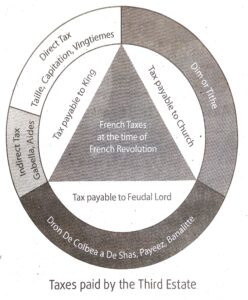
Analytical Answer (AA) Type Questions
Answer in 7 to 8 sentences
1. What do you mean by ‘ancien regime’?
Ans. The term ‘ancien regime’ (old system) is used to describe the conservative society and institutions of France before the outbreak of the French Revolution of 1789. Before the revolution, France was ruled by autocrats of the Bourbon dynasty. They believed in autocratic rule, centralised administration, inherited privilege of the nobility, exploitation of commoners and the support of corrupt churches, etc. The rights of the king were absolute. He was not accountable to the nobility, the church or any institution of the state. All these were the features of the ‘ancien regime’. The ‘ancien regime’ was thus based on a medieval social structure. The French Revolution marked the end of the ‘ancien regime.
2. How far were the Bourbon monarchs responsible for the outbreak of the French Revolution?
Ans. France was ruled by the Bourbon dynasty at the time of the French Revolution. The Bourbon monarchs believed in absolute
Short Answer (SA) Type Questions
Answer in 2 to 3 sentences
1 .What was the nature of monarchy in France before the outbreak of the French Revolution ?
Ans. Despotic monarchy prevailed in France before the outbreak of the French Revolution in 1789. The French monarch believed in the divine right of kingship and regarded himself to be the representative of God on earth. He did not consider himself responsible to anybody for monarchy. There was, however, the StatesGeneral which was a representative assembly but its session was never summoned after 1614. Louis XIV carried the autocracy of the French monarchy to the highest pitch by declaring that ‘the state, it is myself’. The next king, Louis XV, enforced arbitrary legislations and involved France in foreign wars on his own whims. The next king, Louis XVI, was fickleminded and failed to introduce necessary reforms. He failed to control corruption or to remove the privileges of the aristocracy. Thus the Bourbon monarchs were responsible for the outbreak of the French Revolution.
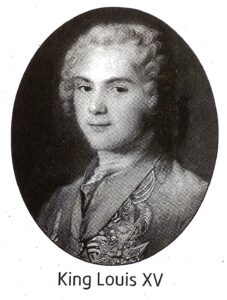
his actions and ruled wilfully. His word was the law of the country.
2 Who was Turgot?
Ans. Turgot was appointed by Louis XVI to the post of Finance Minister to improve the economic condition of France. He wanted to minimise the state expenses and chalked out a detailed programme to improve the economic condition of France. He also intended to impose taxes on the priests and the nobles who were exempted from all sorts of taxes. He was opposed by the queen and the nobles and was removed from his office.
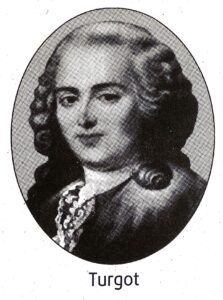
3. Who was Necker?
Ans. Necker was the second finance minister appointed by Louis XVI to improve the economic condition of France. At that time due to the participation of France in the American War of Independence the treasury of France became empty. Necker proposed equal taxation on all classes to fill the treasury. Queen Antoinette criticised him as a miser and the king removed him from his office due to the excessive influence of the queen.
4. Who was Calonne?
Ans. Calonne was appointed by Louis XVI to the office of Finance Minister after Necker was removed. Calonne did not wish to displease the king’s family. So he took huge loans to compensate the deficit of the royal treasury. Soon he realised that the government could not work on the basis of his policy and so he called a meeting of the Assembly of Notables and the king accepted his proposal.
5 . Who was Brienne?
Ans. Louis XVI, the king of France, appointed Brienne as his Finance Minister. He did not succeed in solving the economic problems in France. He proposed some new taxes which were opposed by the Parliament of Paris.
6 . Why was the treasury of France empty when Louis XVI ascended the throne of France?
Ans. Long years of war had drained the financial resources of France. Along with this was the constant cost of maintaining an extravagant court at Versailles. So, the treasury of France was almost empty when Louis XVI ascended the throne of France.
7. How did the American War of Independence affect France’s debt situation?
Ans. The French government supported the thirteen colonies of America in their war of independence against Great Britain. This added more than one billion livres (unit of currency in France) to the national debt that increased to more than two billion livres with interest.
Know More
France extended full support to the American colonies in their War of Independence against the British. Many French troops came back inspired by the ideas of the revolution. These ideas were:
◆ It is right to take up arms against tyranny.
◆ All men should have liberal freedoms.
◆ A republic is superior to a monarchy. These new ideas spread among the people and came into conflict with the ideas that were prevalent in the ‘Ancien Regime.
8 What is ‘Assembly of Notables’?
Ans. The Assembly of Notables was the assembly of the nobles, priests and the magistrates who were appointed by the king himself. The Assembly lacked the representation of the general public because all the members were appointed by the king.
9 What was the ‘s ‘States-General’?
Ans. The ‘States-General’ was a political and legislative body to which the three estates of French society sent their representatives. In France during the Old Regime, the king did not have the power to impose taxes. Rather, he had to call a meeting of the States-General to pass the proposals for new taxes.
Very short Answer (VSA) Type Questions
Answer in one sentence
1. Who was the King of France when the French Revolution broke out ?
Ans. Louis XVI was the King of France when the French Revolution broke out.
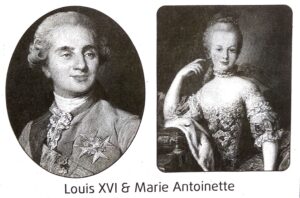
2 . What was the period of rule of Louis XVI ?
Ans. The period of rule of Louis XVI was 17741793.
3. Name the ruling dynasty in France when the French Revolution broke out.
Ans. The ruling dynasty in France when the French Revolution broke out was the Bourbon dynasty.
4 What was the States-General ?
Ans. The States-General was the Assembly of France of which consisted the representatives of the three estates of the French society that passed legislations.
5. When was the States-General summoned by King Louis XVI?
Ans. The States-General was summoned by King Louis XVI on 5 May, 1789.
6. What was ‘Vingtiemes
Ans. ‘Vingtiemes’ was the income tax paid by the peasants of France during the old regime.
7. What is ‘Tithe’?
Ans. ‘Tithe’ was a tax on religion imposed on the members of the Third Estate by the Church.
8 . What is ‘Contract of Poissey ?
Ans. The church of France controlled 1/5 of the landed property of France and paid a voluntary tax to the government by a contract known as the ‘Contract of Poissey’.
9. Which king of France summoned the States-General?
Ans. Louis XVI, the king of France, summoned the States-General.
10 . What was the States-General ?
Ans. The States-General was the representative assembly in France.
11 . After how many years the States-General was called by Louis XVI?
Ans. After 175 years the States-General was called by Louis XVI.
12 . What do you mean by clergy?
Ans. Clergy means group of persons invested with special responsibilites in the church.
13 . What is absolute monarch ?
Ans. The monarch who rules with absolute power is an absolute monarch.
14 . What is constitutional monarch?
Ans. A monarch whose power is limited by the laws provided in the constitution is a constitutional monarch.
15 . What is the meaning of Divine Right of Kingship?
Ans. Divine Right of Kingship means the king regards himself as a representative of God on earth.
16 . Who were the Royalists?
Ans. The supporters of the king were called Royalists.
17 . Who was Marie Antoinette?
Ans. Marie Antoinette was the Queen of Louis XVI. mater
18 . In which two wars France was involved in the 18th century ?
Ans. France was involved in two wars in the 18th century-the Seven Years War (1756-63) and the American War of Independence (1775-83)
19 . Where was the palace of King Louis XVI?
Ans. The palace of King Louis XVI was at Versailles.
20 . In which war France was defeated?
Ans. France was defeated in the war of Austrian succession.
21 . In which year Louis XVI ascended the throne of France?
Ans. Louis XVI ascended the throne of France in 1774.
22 . Where was the session of the StatesGeneral summoned?
Ans. The Session of the States-General was summoned in Versailles.
23 . Why was Turgot appointed by Louis XVI ?
Ans. Turgot was appointed as the Finance. Minister to improve the economic condition of France.
24 . What did Necker propose as a finance minister ?
Ans. Necker, as the finance minister, proposed equal taxation on all classes to fill the
25 . Who said, “the state, it is myself”?
Ans. Louis XIV, the French king, said “the state, it is myself”.
26 . “France was a museum of economic errors” Who said this ?
Ans. Adam Smith said, “France was a museum of economic errors”.
27 . What was Gabella?
Ans. ‘Gabella’ was salt tax collected from the peasants of France.
28 . What was ‘Aides’?
Ans. ‘Aides’ was taxes on wine, tobacco, etc realised from the peasants of France.
29 . What do you mean by ‘Corvee’?
Ans. In ‘ancien regime’ in France the peasants had to work for the reconstruction of roads without any payment which was known as ‘Corvee’.
30 . Who was the author of the book ‘The French Revolution’?
Ans. Thomas Carlyle was the author of the book ‘The French Revolution’.
31 . Which estate in France was exempted from paying taxes in the 18th century France?
Ans. The nobles and the clergy were exempted from paying taxes in the 18th century France.
32 . Which estate paid the most taxes?
Ans. The Third Estate paid the most taxes.
33 . What was ‘capitation’?
Ans. ‘Capitation’ was a direct tax in France before the Revolution of 1789 to be paid by the unprivileged class of the society.
34 . What was Lettre de cachet ?
Ans. ‘Lettre de cachet’ was the order of the king in ‘ancien regime’ in France by which the king could sentence a subject without trial and without an opportunity of defence to imprisonment.
Mark True or False
1. Calonne was the finance minister of France appointed by Louis XV.
2. The entire burden of taxation fell on the First Estate in France.
3. Louis XVI ascended the throne of France in 1774.
4. In 1789 the French Revolution broke out.
5. Marie Antoinette was the Queen of Louis XVI.
6. Clergy means the monarch who rules with absolute power.
7. A monarch whose power is limited by the laws provided in the constitution is an absolute monarch.
8. The representative assembly in France was called the States-General.
Answers :
1. False, 2. False, 3. True, 4. True, 5. True, 6. False, 7. False, 8. True.
Fill in the blanks
1. The ‘ancien regime’ was based on a _________ (ancient/medieval/modern) social structure .
2. The French monarchs were believers in __________ (Divine Right of Kingship/democracy/ dictatorship). SHOHIHIHOIHIMENT
3. Those who were supporters of the king _______ were known as (Girondins/royalists/ monarchists).
4. The States-General in France met on 5 May, 1789 after a long lapse of _______ (174/179/ 196) years.
5. The tithe was a tax on ______ (religion/property/salt).
6. The French Revolution broke out in the year _______ (1788/1789/1776).
7. The French Revolution broke out during the reign of _________ (Louis XIV/Louis XV/Louis
8. Louis XVI ascended the throne of France in _______ (1773/1774/1776).
9. Louis XVI belonged to the ________ (Orange/ Stuart/Bourbon) dynasty.
10. ________ Louis XIV/Louis XV/Louis XVI), the king of France said, “After me the deluge”.
11.________(Rousseau/
12. The king of France ______ (Louis XIV/Louis XV/Louis XVI) said, “I am the state”.
13. _______(Taille/Vingtiemes/
14. Gabella was a tax imposed on ______ (tobacco/salt/wine).
15. _______ (Taille/Gabella/ Vingtiemes) was an income tax of the ancien regime in France.
16. ‘Ancien regime’ means _____(old system/ new system/autocratic system)
17. The _______ (Italian/German/French) ment supported the 13 colonies of America in their war of independence.
Answers :
1. medieval , 2. divine right of kingship, 3. royalists, 4. 174, 5. religion, 6. 1789, 7. Louis XVI, 8. 1774, 9. Bourbon, 10. Louis XV, 11. Turgo, 12. Louis XIV, 13. Taille, 14. salt, 15. Vingtiemes, 16. old system, 17. French.
Choose the best explanation
1. Statement: The French Revolution broke out in 1789 because of –
Explanation (A) : the excesses of king Louis XVI
Explanation (B) : social causes
Explanation (C) : a combination of social, economic, political and intellectual causes.
2. Statement: In 1789, Louis XVI summoned the States-General
Explanation (A) France became bankrupt
Explanation (B) : The Third Estate assembled at Tennis Court to draft a new constitution.
Explanation (C) : A large mob attacked Bastille.
3 . Statement: On the eve of the French Revolution the financial condition of France was miserable.
Explanation (A) : The unjust system of tax collection emptied the treasury of France.
Explanation (B) : The foreign powers looted the wealth of France.
Explanation (C) : France’s involvement in the War of Austrian Succession and in the Seven years War drained her treasury.
4. Statement: The unjust system of tax collection played an important part in the outbreak of the French Revolution.
Explanation (A) : The entire burden of taxation fell on the First Estate.
Explanation (B) : The entire burden of taxation fell on the first two estates.
Explanation (C) : The entire burden of taxation fell on the Third Estate only.
Answers :
1. Explanation C
2. Explanation A
3. Explanation C
4. Explanation C
Multiple Choice Questions (MCQ)
1. The burden of the financial activities of the state during the ‘ancien regime’ was borne by –
A. the king alone
B. nobles only
C. third estate alone
D. church alone
Ans. C
2 . France was defeated in the War of –
A. American Independence
B. Austrian succession
C. World War
D. World War II
Ans. B
3. In 1774, Louis XVI of the Bourbon family ascended the throne of –
A. Germany
B. Italy
C. France
D. Britain
Ans. C
4. The session of the States-General was summoned in 1789 in –
A. Berlin
B. New York
C. London
D. Versailles
Ans. D
5. Which of the following refers to the political body representing the three estates of pre-revolutionary France?
A. Reichstag
B. Provincial Assembly
C. States-General
D. National Assembly
Ans. C
6. The States-General was summoned by
A. Louis XVIII
B. Louis XV
C. Louis XVI
D. Louis XIV
Ans. C
7. The States-General was the representative
A . Germany
B. Italy
C. Spain
D. France.
Ans. D
8. Louis XVI ascended the throne of France in
A. 1774
B.1773
C. 1775
D .1875
Ans. A
9. The dynasty which ruled in France when the French Revolution broke out was
A. Stuart
B. Tudor
C. Bourbon
D. Yamato
Ans. C
10. The States-General representatives of
A. First Estate
B. Second Estate
C. Third Estate
D. Three Estate
Ans. D
11. The States-General was summoned by king Louis XVI on
A. 5 May, 1789
B. 6 May, 1788.
C. 5 May, 1788
D 12 April, 1789
Ans. A
12. The tax on religion imposed by the church was –
A. Vingtiemes
B. Corvee
C. Taille
D. Tithe
Ans. D
13. Tithe, a tax on religion, was imposed on the members of –
A. Third Estate
B. First Estate
C. All estates
D. Second Estate
Ans. A
14. The free labour rendered by the French peasants for the renovation of roads and buildings was known as –
A. Gabella
B. Vingtiemes
C. Corvee
D. Tithe
Ans. C
15. Turgot, the Finance Minister, was appointed by –
A. Louis XIV
B. Louis XVI
C. Louis XV
D. Louis XVIII
Ans. B
16. Necker, the Finance Minister of France, was removed from his office by–
A. Louis XVI
B. Calonne
C. Rousseau
D Brienne
Ans. A
17. The French government supported the thirteen colonies of America in their war against
A. Spain
B. Italy
C. Great Britain
D. Germany
Ans. C
18. The members of the Assembly of Notables was appointed by the –
A. Finance Minister
B. States General
C. Queen
D. King
Ans. D
19. During the old regime, the king to pass proposals for new taxes had to call a meeting of the –
A. Finance Minister
B. States-General
C. First Estate
D . Aristocrats
Ans. B
20. The session of the States-General was never summoned after-
A. 1614
B. 1615
C. 1514
D. 1715
Ans. A
21. ‘France was a museum of economic errors’ was remarked by
A. Vincent Smith
B. Talleyrand
C. Rousseau
D. Adam Smith
Ans. D
22. Louis XIV ruled during the period –
A. 1643-1720 AD
B. 1643-1715 AD
C. 1642-1720 AD
D. 1640-1716 AD
Ans. B
23. The administrative official under the ancien regime was known as –
A. Intendant
B. Jacobins
C. Girondins
D. Consul
Ans. A
TOPIC – B
French Society Prior to the Outbreak of the French Revolution and the Role of French Philosophers
Explanatory Answer (EA) Type Questions
Answer in 12 to 15 sentences
1. Describe the social structure of France prior to the outbreak of the French Revolution.
Ans. Prior to the outbreak of the French Revolution the society in France was based on a medieval structure. Society was divided into three estates:
(1) First estate: The clergy belonged to the first estate. They enjoyed certain privileges by birth. They were exempted from paying taxes to the state. They owned 10%-15% of all the land in France. The corrupt lifestyle of the clergy was reflected in its attempts to impose mortuary fees, marriage fees and succession fees.
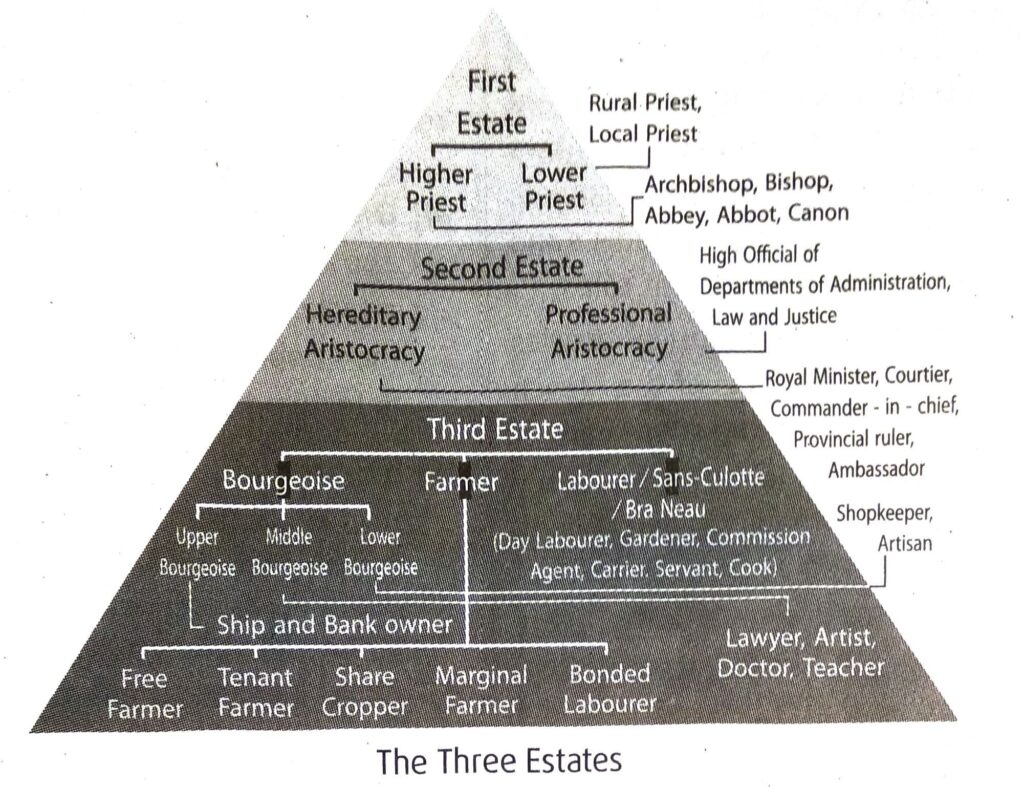
(2) Second estate: The second estate in France was composed of the French aristocracy and the landed class. They were also exempted from paying taxes. They enjoyed a large part of landed resources in the countryside.
(3) Third estate: About 90% of the population of the third estate were peasants. They had to work in the fields of their landlords as well as in their houses. They had to pay direct taxes like taille and also a number of indirect taxes like capitation, vingtiemes and so on. They also had to pay taxes on articles of everyday use. The third estate was the most exploited social class in 18th century France.
2 . What were the two main classes into which the French society was divided? Describe them.
Ans. The French society was divided into two main classes: [1] the privileged and [2] the unprivileged.
The privileged class: The privileged class comprised the nobles, feudal lords and the higher clergy. They enjoyed all rights and privileges. All important posts were reserved for them. Apart from high posts in the administration, the sons of the nobles were appointed on lucrative posts in the church. They used to collect various taxes from the commoners while they themselves were free from all sorts of taxation. They led a life of pleasure, luxury and immorality.
The unprivileged class: The unprivileged class consisted of the peasants, tenants, labourers, artisans, small traders and shopkeepers. They were not given any privileges like the nobles. They had to pay taxes and were not appointed to any lucrative post. The revenue collectors tortured them severely. In case of non-payment of dues the revenue staff used to torture them. They were greatly discontented with the prevailing system of government and the social system.
3. What was the role of French philosophers in the outbreak of the French Revolution?
Ans. The revolutionary ideas in France were preached and propagated by famous thinkers and philosophers like Rousseau, Montesquieu, Voltaire, Denis Diderot. The Encyclopaedists and the physiocrats also played important roles.
(1) Voltaire: Voltaire wrote satirical articles against the evils and defects of the French government. He rejected the supremacy of the church outright and held the clergy responsible for spreading blind faith among the people. He was an advocate of individual freedom.
(2) Montesquieu: Montesquieu preached the Doctrine of Separation of Powers instead of concentrating the powers in the hands of monarch. He suggested that the three organs of government, i.e. the legislature, the judiciary and the executive, must be independent of each other.
(3) Rousseau: Rousseau was the author of the book ‘Social Contract’ where he proposed a form of a government based on social contract between the people and their representatives. He emphasised that a king should consider himself a servant of humanity and should serve them heart and soul.
(4) Denis Diderot: Denis Diderot violently opposed all ancient institutions. He attacked king’s autocracy, the privileges of the nobility and the church and the defective tax system.
(5) Physiocrats: The economic thinkers of France criticised the economic policy of the French government. Economic thinkers like the physiocrats strongly criticised the mercantile doctrine and advocated free trade, privatisation of trade and industry. Quesnay and Adam Smith were the spokesmen of the doctrine of free trade and the removal of state control so far prevalent in the field of trade and commerce (Laissez-faire).
Analytical Answer (AA) type Questions
Answer in 7 to 8 sentences
1. What was the role of Voltaire in the outbreak of the French Revolution?
Ans. Voltaire was one of the most important French philosophers who played a very significant role in the outbreak of the French Revolution. He wrote satirical articles against the evils and defects of the French government. He was twice imprisoned for his satirical writings. He rejected the supremacy of the church outright and held the clergy responsible for spreading blind faith among the people. He protested against the corrupt and luxurious life of the clergy and denounced the church as an ‘infamous thing’. He was against the religious dogmas of the priests. He vehemently criticised all kinds of oppression, exploitation, blind beliefs and evil practices. He was an advocate of individual freedom.
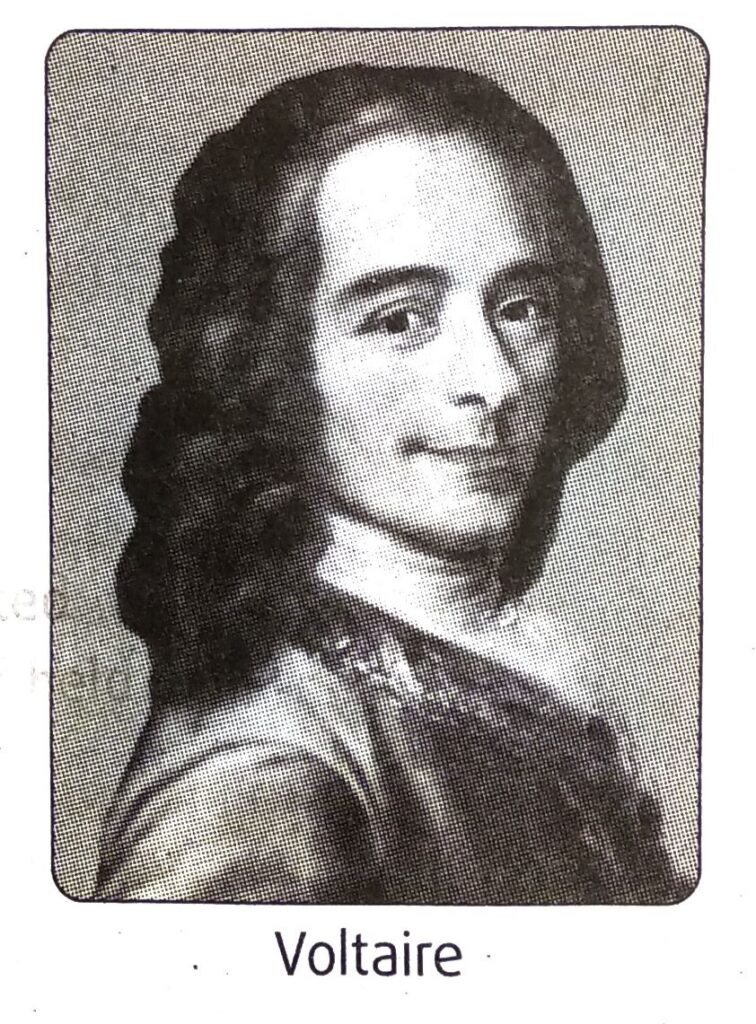
2. Who was Diderot ?
Ans. Diderot was an important philosopher of France who contributed greatly to the outbreak of the French Revolution. He violently opposed all ancient institutions. In 1751 he edited an Encyclopaedia which had twelve volumes. Between 1751 and 1772 seventeen editions of this were published. This encyclopaedia gave birth to rationalism in France. He attacked the king’s autocracy, the privileges of the nobility and the church, the defective tax system, slave system and the blind faith of the French people. He was imprisoned by the French government because of his fearless thoughts and writings.
3. How did the economic thinkers criticize the economic policy of the French government?
Ans. The economic thinkers of France criticized the economic policy of the French government. They came out with new economic ideas. Economic thinkers like the physiocrats, strongly criticized the mercantile doctrine and advocated free trade, free enterprise, privatiza- tion of trade and industry. Quesnay, the most outstanding of the physiocrats and his professor Adam Smith were the spokesmen of the doctrine of free trade and the removal of state control so far prevalent in the field of trade and commerce (Laissez-faire). They came forward with rational exposition of economic laws.
4. What was the doctrine of ‘Separation of Powers’ preached by Montesquieu ?
Ans. Montesquieu preached the doctrine of Separation of Powers instead of concentrating the powers in the hands of monarch. According to him a king will be tyrannical if he concentrates in his hands, the three organs of government the executive, the judiciary and the legislature. He suggested that the three organs of government must be independent of each other.
5 . Who were the ‘sans-culottes’?
Ans. The ‘sans-culottes’ belonged to the third estate of French society. They included small shopkeepers, artisans such as pastry cooks, shoemakers, printers, watchmakers as as daily wage-earners and servants. They used to wear long-striped trousers. This was to differentiate them from the fashionable groups in the French society, especially nobles who wore knee breeches. They wore, in addition, the red cap that symbolised liberty. Food riots were started by them. On 10 August 1792 they attacked and entered the Royal Palace at Tuileries.
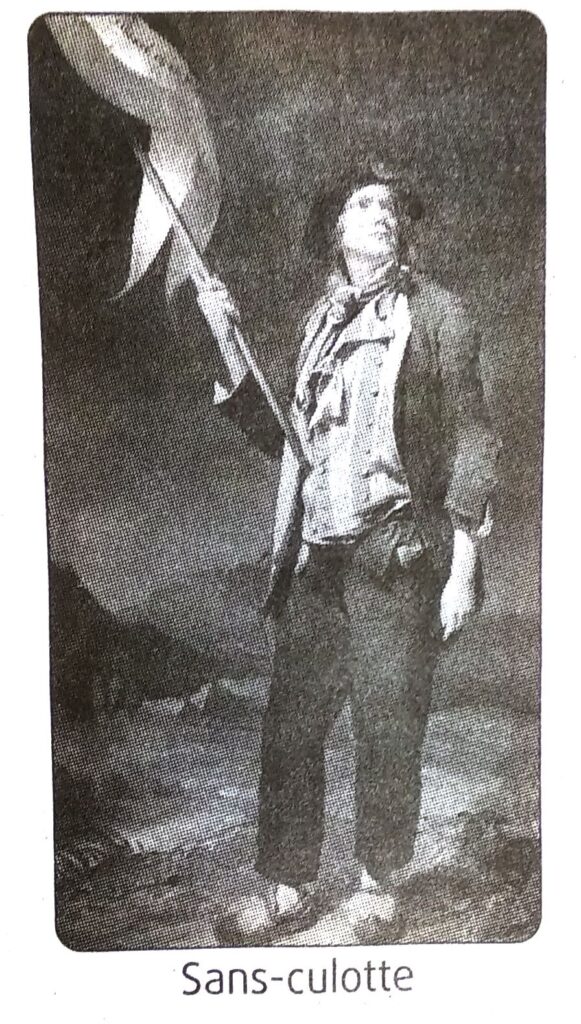
6 . What was the position of the bourgeoisie in French society ?
Ans. French society was divided into two classes-[1] the privileged and [2] the unprivileged. The ‘bourgeoisie’ belonged to the unprivileged class. The bourgeoisie or the middle class was rich and consisted of physicians, lawyers, philosophers and professors. Heavy taxes were levied on them by the government but they did not enjoy any privileges such as those enjoyed by the aristocracy. They were not appointed to any high posts in spite of their capability and so they were discontented. They were determined to go to any extent to bring liberty and equality in society and the way they chose was to bring down the aristocratic privileges. The French Revolution was really led by the bourgeoisie for it was they who organised the people and inspired them to revolt.
Short Answer (SA) Type Questions
Answer in 2 to 3 sentences
1. Who was Rousseau?
Ans. Rousseau was a French philosopher who through his works prepared the intellectual ground for the outbreak of the French Revolution. He was the author of the book ‘Social Contract’ where he proposed a form of government based on social contract between people and their representatives. He emphasised that a king, instead of regarding himself as an absolute monarch, should consider himself a servant of humanity and should serve them heart and soul.
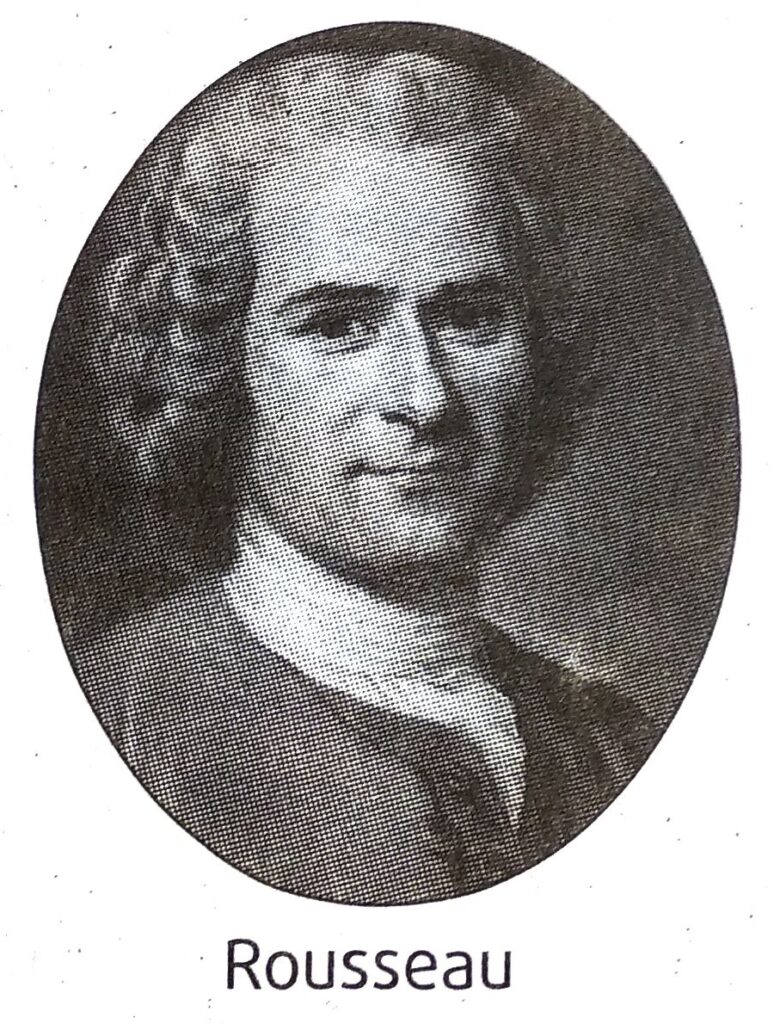
2 . Who was Montesquieu?
Ans. Montesquieu was a great French philosopher. He was the author of the famous book ‘The Spirit of the Laws’. In this book he proposed a division of power between the legislature, the executive and the judiciary. In his book ‘The Persian Letters’ he criticised the aristocracy, the monarchy and the French social system.
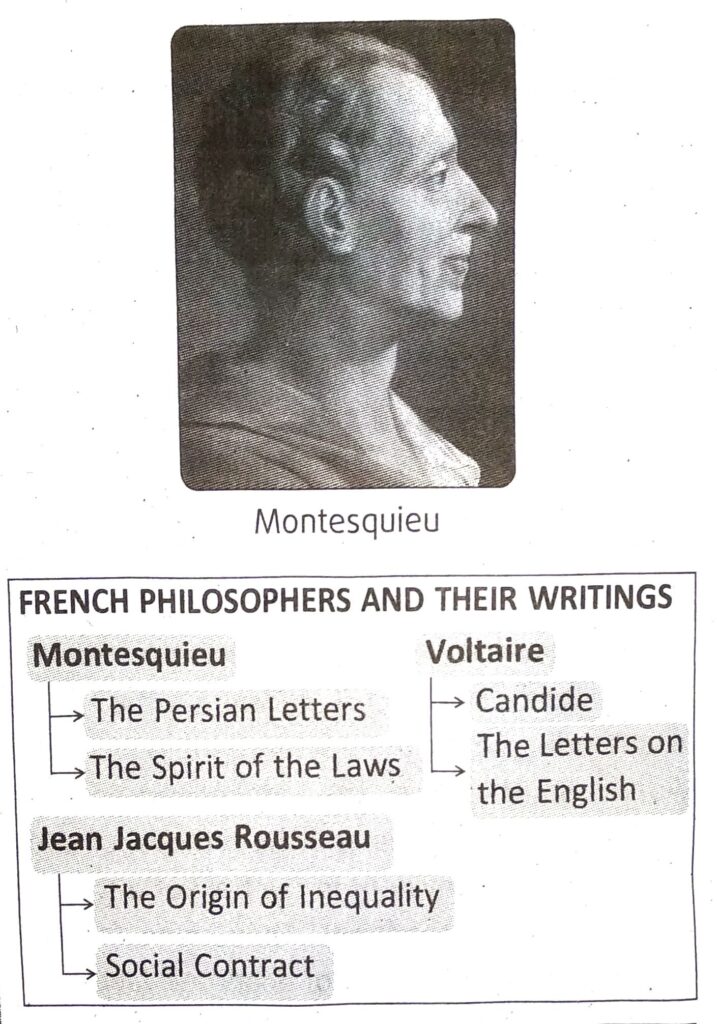
3 . Who were the physiocrats?
Ans. The physiocrats were the economic thinkers of France who strongly criticised the mercantile doctrine and advocated free trade, privatisation of industry and trade.
4 . Who was John Locke?
Ans. John Locke was a popular and progressive English philosopher. His writings fuelled the thought of revolution against the existing monarchical system among the French people. He refuted the doctrine of the divine and absolute right of the monarch in his book ‘Two Treatises of Government’.
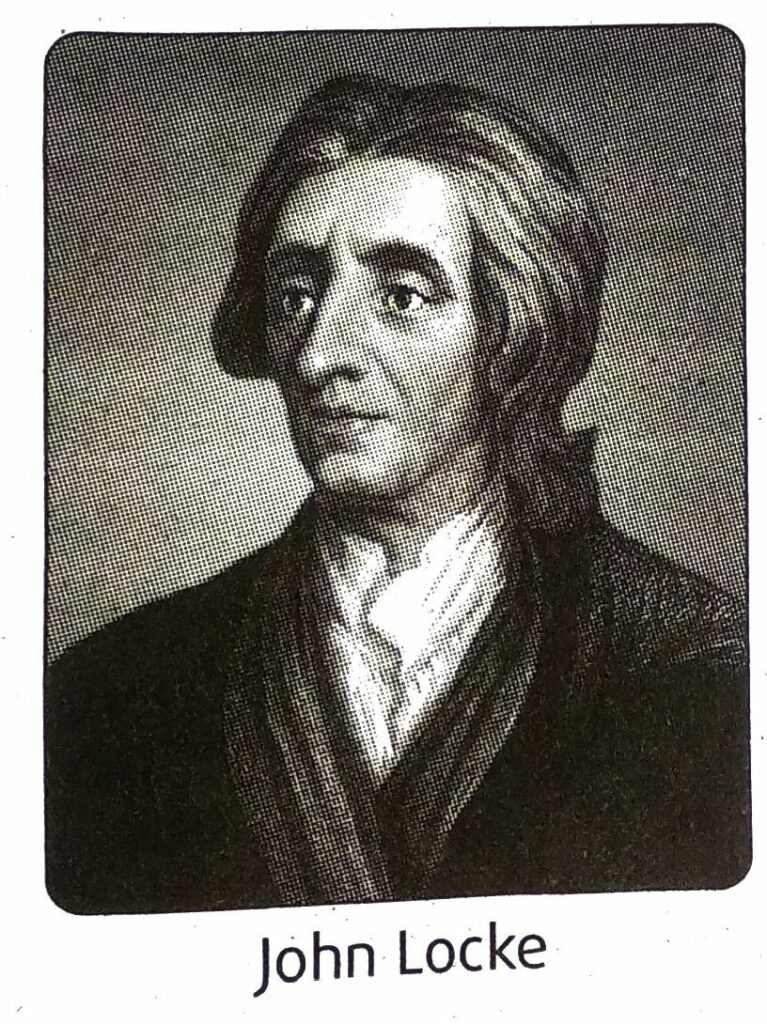
5. What were the three estates in the French society?
Ans. Prior to the French Revolution, the people of France were divided into three estates -[1] There were the clergy holding the first estate. [2] The second estate comprised the French aristocracy and landlord. [3] The rest of the Frenchmen were grouped in the third estate.
6 . What was the third estate in the French society? was the third
Ans. The third estate in France was divided into several sub-groups. The upper bourgeoise comprised of financiers, businessman, etc. The lower bourgeoise comprised of lawyers, teachers, salaried classes and shopkeepers. In the third estate there were also the peasants, sans-culottes, mill hands and daily wage earners.
7 . What is divine right of kings?
Ans. The divine right of kings was a political and religious doctrine. It meant that a king was given the right to rule by God alone. His authority could not be questioned by anybody because he ruled in the name of God. It gave a king full power over his subjects.
8 . Why were the Intendants compared to ‘ravenous wolves’?
Ans. Intendants were the government officers of France. They were known for their selfish and corrupt nature. These officials badly tortured the people for collecting taxes, the larger part of which was misappropriated by them. This is why they were compared to ‘ravenous wolves.
9. What was the social composition of the sans-culottes?
Ans. The sans-culottes were the economically disadvantaged groups, who mostly inhabited the urban areas of France. The urban proletariates, the wage earners, mill hands, the roofless down outs of the society, the daily workers formed that section.
10. Which class in the French society was known as “bourgeoisie’?
Ans. In France, by the eighteenth century, a new social class known as ‘bourgeoisie’ or the middle class emerged. The doctors, writers, professors, big businessmen, lawyers, peasants, shopkeepers, workers formed this class. They challenged the supremacy and special privilege of the aristocrats.
11 What was the ‘Aristocratic Revolt’?
Ans. The French Revolution began with the revolt of the aristocracy. The tax burden on the peasantry was already very high, the only method of increasing government income was to take away from the aristocracy the privilege of not paying any tax. This was opposed by the aristocrats and the ‘Aristocratic Revolt’ broke out.
Very short Answer (VSA) type Questions
Answer in one sentence
1. Name two philosophers of the French Revolution.
Ans. Two philosophers of the French Revolution were Rousseau and Montesquieu.
2. Who were the physiocrats?
Ans. The physiocrats were economists who demanded free trade, free enterprise and privatisation of industry and trade.
3 Who was the leader of the physiocrats of France?
Ans. Francois Quesnay was the leader of the physiocrats of France.
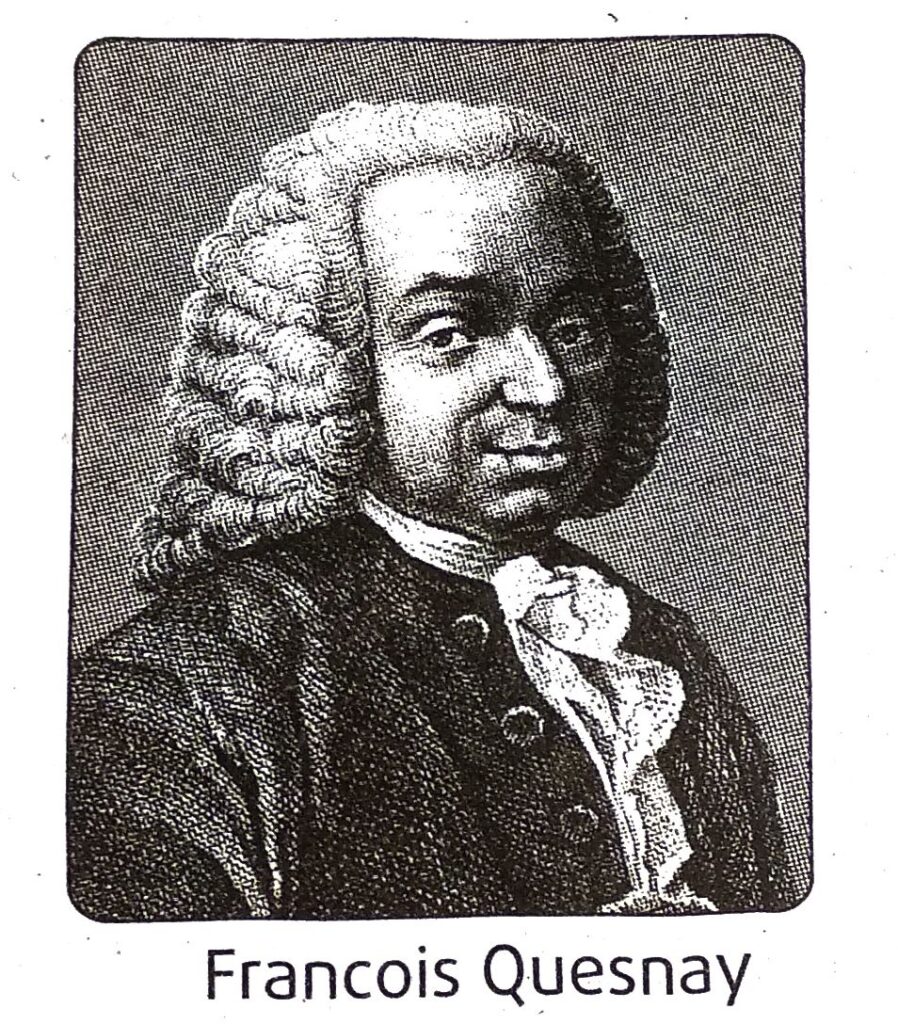
4. What were the three ideals of the French Revolution?
Ans. The three ideals of the French Revolution were Liberty, Equality and Fraternity.
5 . Who remarked, “Man is born free, but everywhere is bound by chains”?
Ans. Jean Jacques Rousseau remarked “Man is born free, but everywhere is bound by chains.”
6. Who was Quesnay?
Ans. Quesnay was the spokesman of the doctrine of Laissez-faire and the removal of state control on the industry.
7. Who was the author of the book “The Spirit of Laws”?
Ans. The author of the book “The Spirit of Laws” was Montesquieu.
8 . Who preached the doctrine of Separation of Powers ?
Ans. Montesquieu preached the doctrine of Separation of Powers.
9. What are the three organs of government ?
Ans. The three organs of government are legislative, executive and judiciary.
10. What does Laissez-faire mean?
Ans. Laissez-faire means that government does not interfere with trade and economy and decisions are left for private individual to take.
11. What do you mean by separation of powers?
Ans. Separation of powers means the three branches of government, i.e., the executive, the legislative and the judiciary-are kept separate so that power is not concentrated in one branch.
12 Name two encyclopaedists of France.
Ans. Two encyclopaedists of France were Denis Diderot and D’Alembert.
13 Who spoke in favour of free trade (laissezfaire)?
Ans. Economist Adam Smith in his book ‘The Wealth of Nations’ spoke in favour of free trade (laissez-faire).
14 Who was the author of the book ‘The Wealth of Nations’?
Ans. Adam Smith was the author of the book ‘The Wealth of Nations’.
15 What do you mean by Lettre de Cachet?
Ans. Prior to the French Revolution any person could be arrested and confined without trial by virtue of a royal warrant of arrest called Lettre de Cachet.
16. Who were the Intendants?
Ans. The government officers of France who served as agents of the king in provinces were known as Intendants.
17. What was the Contract of Poissey?
Ans. The church of France paid a voluntary tax to the government by the Contract of Poissey.
18. When did food riots by the sans-culottes start in France?
Ans. Food riots by the sans-culottes started in France in 1787.
19. Who belonged to the First Estate in the French society ?
Ans. The clergy belonged to the First Estate in the French Society.
20. Who belonged to the privileged class in the French society?
Ans. In the French society the clergy and the nobility belonged to the privileged class.
21. What was The Council of Notables ?
Ans. The Council of Notables was a body, th members of which were nominated by th king himself and convened by the king o extraordinary occasions to consult o matters of government.
22 . Into how many classes clergymen were divided in France?
Ans. Clergymen were divided into two classes in France-[1] the upper clergy and [2] the lower clergy.
Mark True or False
1. Denis Diderot was a French Encyclopaedist.
2. Quesnay was the spokesman of the doctrine of Laissez-faire.
3. The most outstanding composition of Voltaire was the ‘Persian Letters’.
4. In France the clergy belonged to the third estate.
5. The church paid a voluntary tax to the government if they willed by the Contract of Poissey.
6. The aristocracy and landlord in France formed the Third Estate.
7. Economic historians refute the theory of philosophy playing any considerable part in the outbreak of the French Revolution.
8. The French philosophers did not directly preach for revolution, rather they wanted reform of the old order.
9. The physiocrats did not advocate free trade and privatisation of industry and trade.
10. Scattered peasant revolts and food riots by sans-culottes due to scarcity of food supply started from 1787.
11. Rousseau in his famous book ‘The Spirit of Laws’ attacked the divine right of kings.
12. The ‘Persian Letters’ was written by Montesquieu.
13. The three organs of government are-the executive, the judiciary and the legislature.
14. Montesquieu suggested that the three organs government must be independent of each other. of
15. ‘Discourses on the Origin of Inequality’ was written by Quesnay.
Answers :
1. True, 2. True, 3. False, 4. False, 5. True, 6. False, 7. True, 8. True, 9. False, 10. True, 11. False, 12. True, 13. True, 14. True, 15. False.
Fill in the blanks
1. The French Revolution began with the revolt of the ________ (peasants/aristocrats/ philosophers).
2. The Council of Notables was a body the members of which were nominated by the ________ (king/aristocrats/finance inister).
3. Aristocratic Revolt was the clash between the _______ (nobles/Parliament/
4. Calonne was the finance minister of _______ (Louis XIV/Louis XV/Louis XVI).
5. Encyclopaedia was edited by_________ (Quesnay/Denis Diderot/Roussau).
6. Laissez-faire means _______(parliament/ clericalism/free trade).
7. The author of the book ‘Social Contract’ was _______ (Denis. Diderot/Montesquieu/Rousseau).
8. The clergy in France belonged to the _________ (third/first/second) estate.
9. _______(Second/First/Third)
Answers :
1. aristocrats
2. king
3. aristocrats
4. Louis XVI
5. Denis Diderot
6. free trade
7. Rousseau
8. first
9. Third
Choose the best explanation
1. Statement : The aristocrats of France revolted.
Explanation (A) : The privilege of not paying any tax was taken away.
Explanation (B) : They were not allowed to speak in the States General.
Explanation (C) : They were not appointed to high posts.
2. Statement : Montesquieu Statement: separation of powers.
Explanation (A) : It is required to control the autocratic monarachy.
Explanation (B) : It is required to abolish the claims of aristocracy.
Explanation (C) : It is required to rule according to the wish of the people.
3. Statement: The people of the third estates hated the aristocracy.
Explanation (A) : The aristocracy unjustly enjoyed special privileges:
Explanation (B) : The aristocrats were spies of enemy state.
Explanation (C) : The population of third estates was large.
Answers :
1. Explanation (A)
2. Explanation (A)
3. Explanation (A)
Multiple Choice Questions (MCQ)
1. The spokesman of the doctrine of Laissez faire was –
A. Quesnay
B. Denis Diderot
C. Rousseau
D.Voltaire
Ans. A
2 . The author of ‘Persion Letters’ was –
A. Voltaire
B. Quesnay
C. Montesquieu
D. Rousseau
Ans. C
3 . The doctrine of ‘Separation of Powers’ was advocated by –
A. Montesquieu
B. D’Alembert
C. Adam Smith
D. Rousseau
Ans. A
4. Eighteenth century French society was divide into –
A. Two estates
B. Four estates
C. Castes
D. Three estates
Ans. D
5 Which of the following in the French society constituted the privileged class ?
A. clergy and peasants
B. clergy and nobility
C. first and third estates
D. peasants and nobility
Ans. B
6 Society based on freedom, equal laws and opportunities was advocated by –
A. Nobility and clergy
B. Middle class
C. Louis XVI
D. Philosophers like John Locke’ and Rousseau
Ans. D
7 Who is known as the father of French Revolution ?
A. Rousseau
B. Louis XVI
C. Adam Smith
D. Quesnay
Ans. A
8 Revolt was first started in France by –
A. Clergy
B. Aristocrats
C. Peasants
D. Bourgeoise
Ans. B
9 In France the percentage of people belonging to the third estate was –
A. 99%
B. 50%
C. 97%
D. 80%
Ans. C
10 Which of the following did not belong to the third estate?
A. peasants
B. labourers
C. workers
D. clergy
Ans. D
TOPIC . C
Fall of Bastille, Popular Revolt and the Ideals of Liberty, Equality and Fraternity
Explanatory Answer (EA) Type Questions
Answer in 12 to 15 sentences
1. Did women in France play any role in the Revolution in 1789?
Ans. From the very beginning, the women of France were active participants in the events related to the French Revolution of 1789. [1] Most women did not have access to education or job training.. Only daughters of
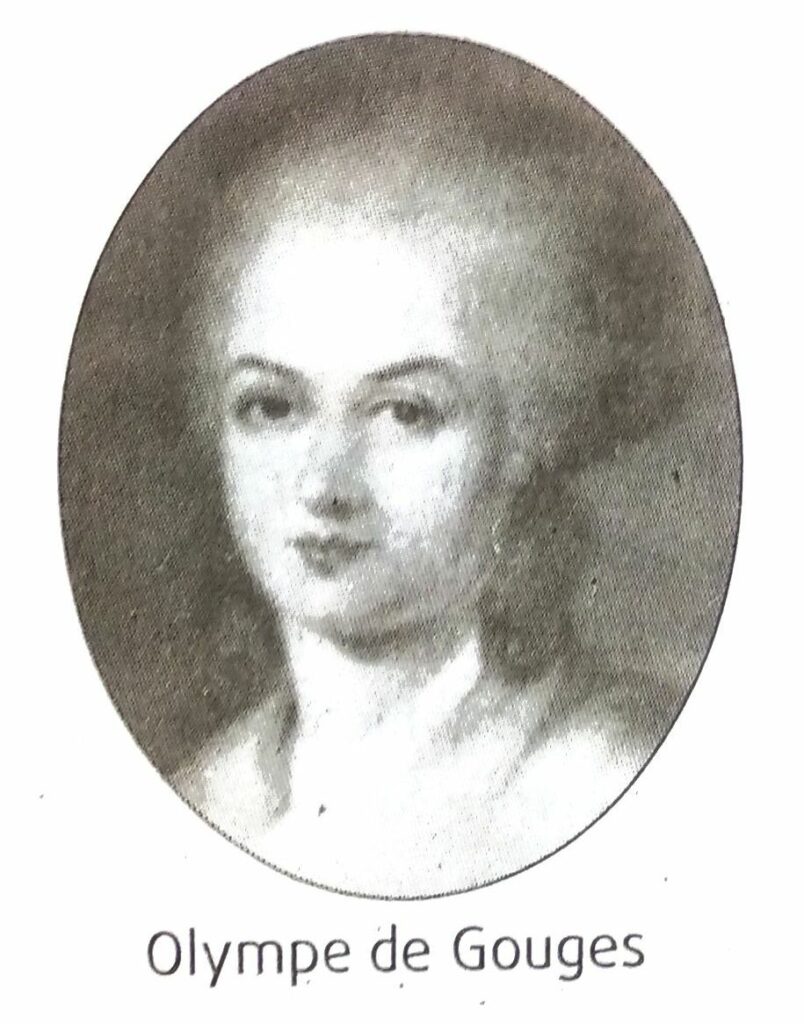
nobles or the wealthier members of the Third Estate could study at a convent. On 5 October, 1789, the poorest women of France, angered by price rise and the indifferent attitude of the king to their misery, led a long march of 12 miles on the highway from Paris to Versailles shouting ‘Bread! Bread! Bread!’ [2] In order to voice their concerns and issues, women started their own political clubs and newspapers. About 60 women’s clubs came up in different cities of France. The ‘Society of Revolutionary and
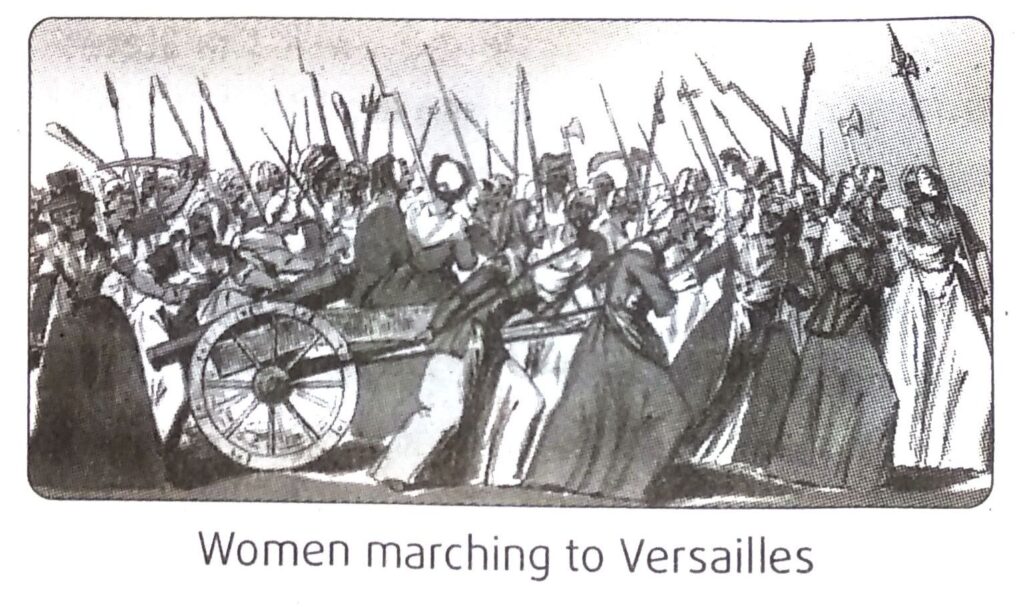
Republican Women’ was the most famous of these. Olympe de Gouges was one of the most politically active women of the revolutionary period in France. [3] The constitution of 1791 reduced the rights of women. So they demanded the right to vote, the right to contest elections and to hold political office. During the Reign of Terror the French government issued laws banning the political participation and activities of women and ordered the closure of women’s clubs. The fight for voting rights and equal wages continued. Finally in 1946 women won the right to vote.
2. What were the causes of agrarian revolt (or, spread of rural unrest) in France in 1789? What is its importance?
Ans. Various causes were responsible for the outbreak of agrarian revolt in France in 1789. [1] The immediate cause of the revolt of the peasantry was the ‘Great Fear’. The ‘Great Fear’ was the rumour that spread in villages that criminals and brigands had been sent against the peasantry by the nobility. It was actually the plan made by the nobility to avenge their defeat in the States-General. [2] Another cause of the revolt of the peasants was the rise in prices of bread. In fact, a time came when higher prices could not procure bread. [3] The fall of Bastille and other violent incidents in different parts of France provoked the peasants to break out in rebellion. [4] The peasants who had been suffering for long under feudal tyranny were disillusioned at the StatesGeneral meeting as they realised that it could not bring any change in their material life.
The importance of the agrarian revolt in France are as follows-[1] It opened the eyes of the elected representatives of the people in the States-General. [2] The violent incidents and the attacks upon the property of feudal lords by the rebel peasants convinced the elected representatives that for the security of their own property, some concessions had to be granted. [3] On August 14, 1789 the nobility and the clergy voluntarily renounced the privileges they had been enjoying for a long time. As a result, feudalism came to an end in France.
3. What was the role of the Jacobins? What were the causes of the downfall of the Jacobins?
Ans. After the downfall of the Girondists, the Jacobins captured power. The prominent members of the Jacobin party were Danton, Marat and Robespierre. In order to terrorise the supporters of monarchy, they advocated the establishment of the Reign of terror. The chief organs of the Reign of Terror were[1] The Committee of Public Safety, [2] The Committee of General Security and [3] Revolutionary Tribunal by which the suspects were put to death after a summary trial.
The chief weapon to establish control over the public of France were the ‘Law of Maximum’ and the ‘Law of Suspects’. Thousands of people were guillotined by the help of ‘Law of Suspects’ on the ground of mere suspicion. Many were punished for non-compliance of the Law of Maximum. Thus during the Reign of Terror they let loose tremendous atrocities on the people and put an end to the Girondists who opposed their policy.
Various causes led to the downfall the Jacobins. [1] The differences of opinion among the Jacobins contributed to their downfall. [2] The life and property of the people were not safe during the Reign of Terror and so the people opposed it. [3] The Jacobin leader Robespierre began to interfere in the religious beliefs of the people which hurt their feelings [4] The labourers were annoyed with the party as they had fixed their wages under the Law of Maximum. [5] The machinery of the Reign of Terror alienated the sympathy of the people and the Jacobins lost their ground.
4. What were the results of the French Revolution?
Ans. The results of the French Revolution of 1789 are discussed below
[1] The revolution brought an end to the privileges of the clergy and the nobility.
[2] It laid down that every nation should be free to choose its form of government. own
[3] It ended the arbitrary rule of the king and developed the idea of a peoples’ republic.
[4] It emphasised the principle of equality. All men were made equal in the eyes of law.
[5] It asserted that each individual should have liberty of speech, worship and personal liberty.
[6] To the liberals, the principle of civil equality and national sovereignty offered a model for an exploitation-free, progressive sociopolitical system.
[7] After the revolution, the sovereign will of No the people gained importance. government could justify its existence unless it rested upon the consent of the people.
[8] The political developments in 1789 in the conservatives France apprehensive of a further outbreak of revolutionary fervour.
[9] The ideas of democracy, nationalism, liberalism and fraternity stirred the minds of European people.
[10] It inspired revolutionary movements in almost every country of Europe and in south and central America.
Analytical Answer (AA) Type Questions
Answer in 7 to 8 sentences
1. What was the ‘Tennis Court Oath’?
Ans. The States-General, an assembly that drafted and passed legislation in France, was summoned by Louis XVI on 12 June, 1789. The conflict started with the voting system of the States-General. The nobles and the priests wanted voting by order while the members of the third estate demanded that votes should be counted individually and the States-General should be recognised as the National Assembly of France. On 20 June, 1789 the king closed the meeting room of the Third Estate and posted armed soldiers at the entrance. When the representatives of the third estate reached the meeting hall, they were stunned to see the doors shut. So they assembled at the nearby tennis court and took an oath not to move from there until they had prepared a new constitution for the country. At last, the king agreed to the proposals of one vote per head.
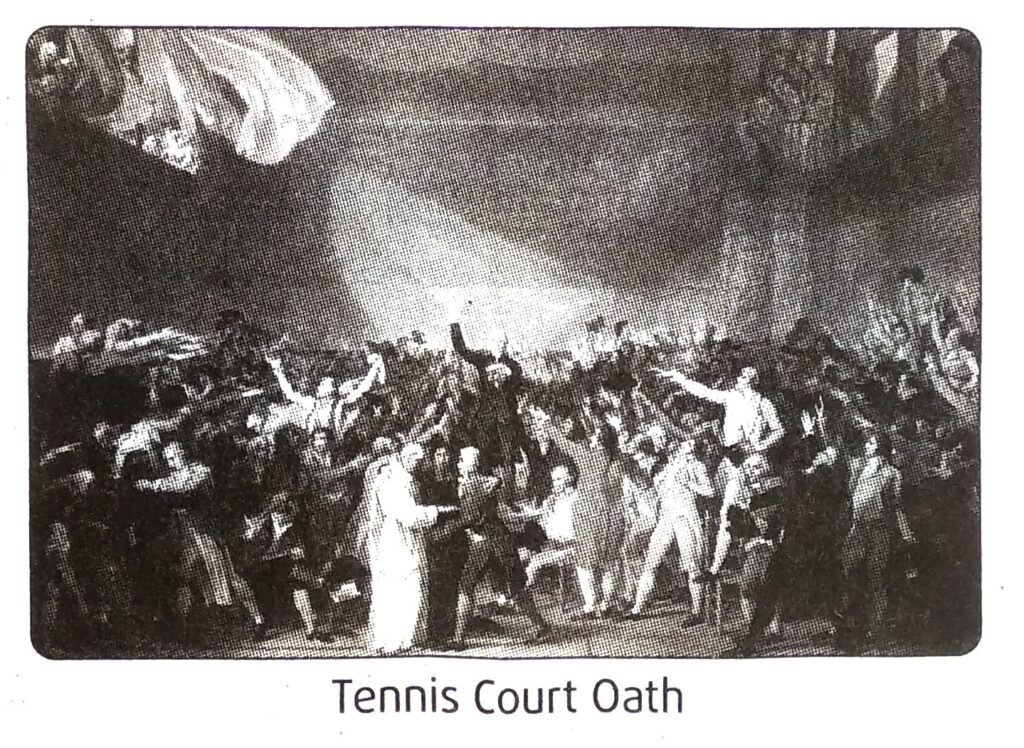
2. What rumour spread in Paris on the morning of 14 July, 1789? What was the reaction of the people?
Ans. On the morning of 14 July, 1789, the people of the city of Paris were in a state of alarm. The king ordered his troops to move into the city. Rumours spread among the people that he would soon order his army to open fire upon the citizens.
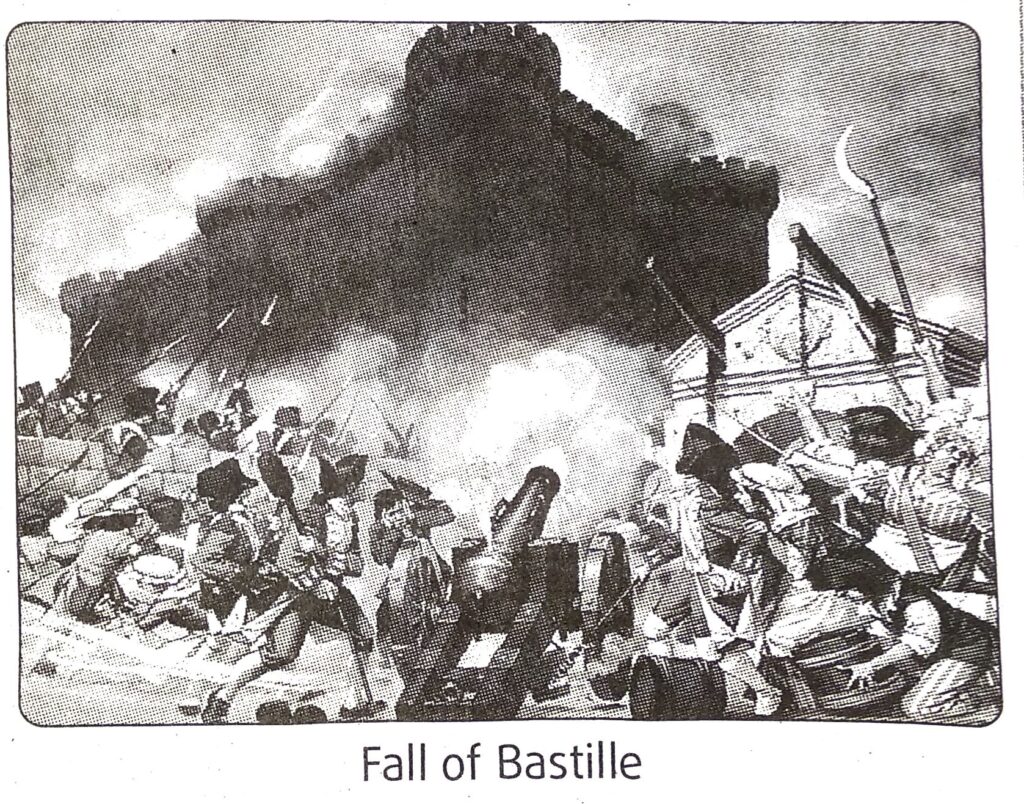
As a result about 7000 men and women gathered in front of the town hall and decided to form peoples’ militia. A group of several hundred people marched towards the eastern part of the city of Paris and stormed the fortress-prison, the Bastille in the hope of finding hoarded ammunition. The angry mob stormed the Bastille.
3. Give an account of King Louis XVI’s attempt to escape from France.
Ans. Mirabeau, the ablest leader in the National Assembly, had a good relationship with king Louis XVI. Mirabeau died in 1791 and the king became very perturbed. In the
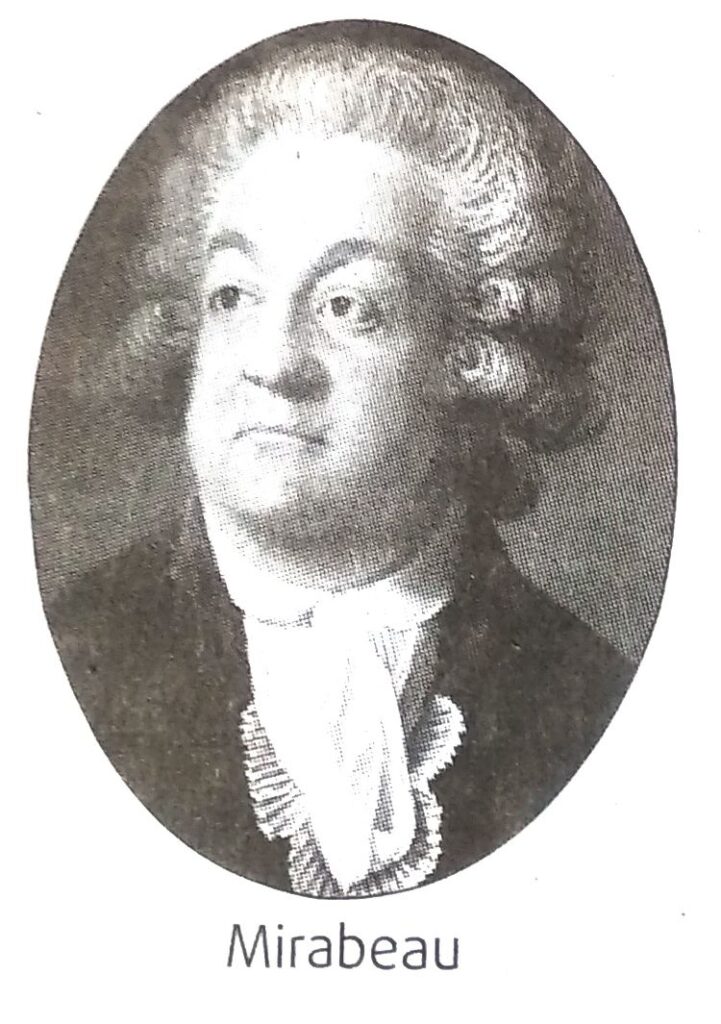
meantime, other European monarchs were preparing to attack France. Louis XVI, with a view to reestablish autocracy in France, tried to escape to Austria along with his family on the night of 21 June, 1791. King Leopold of Austria was the brother of the queen of France. Unfortunately their attempt failed. They were captured in the village Varnnes, and brought back to Paris under great insult.
4. How did the French Constituent Assembly limit the powers of the king?
Ans. The Constituent Assembly declared France to be a constitutional monarchy. [1] The king lost his divine right of kingship. He was treated as ‘first servant of the state’ and ‘ became a salaried head of the state. [2] He became the head of the administrative or executive department according to the doctrine of separation of powers. [3] He did not have any power to wage war or to make treaties with any country. [4] He lost control over the provincial governments as well. [5] He lost his earlier right of exercising control over the legislative body and the judiciary.
5. What was said in the ‘Declaration of the Rights of Man and Citizen’?
Ans. On 26 August, 1789 the French Constituent Assembly drew up a ‘Declaration of the Rights of Man and Citizen’. It said-[1] All men are born free, remain free and have equal rights. [2] All citizens are equal in the eyes of law. [3] The source of all sovereignty resides in the nation. [4] Liberty consists in the freedom to do everything which does not harm others. [5] Right to property is a sacred law, Property of any person cannot be usurped without payment of proper compensation. [6] Rights consist in expressing free opinion, freedom of the individual and freedom of religious belief. [7] No individual shall exploit others. [8] No one can be arrested or imprisoned by the police unless proved guilty in the eyes of law.
In short the declaration emphasized the three basic principles of the French RevolutionLiberty, Equality and Fraternity.
6. When and how was the feudal system abolished in France ?
Ans. On 4 August, 1789 the French Constituent Assembly issued a declaration which abolished feudalism from France. The declaration was as follows: [1] Henceforth feudalism with all its privileges would be abolished. [2] The feudal class would lose all its inherited social and political privileges. [3] The church taxes like tithes and others of ecclesiastical privileges were to be renounced. [4] Serf system, all forms of feudal taxes, forced labour or corvee and manorial system were to be abolished.
But feudalism could not be abolished totally. The nobles and the clergy retained some of their privileges.
7. Describe the revolt of the peasants in rural France after the fall of the Bastille.
Ans. After the storming of the Bastille on 14 July, 1789, the peasants of France who had been suffering under feudal tyranny rose in revolt. They burnt the houses of the landlords as well as the churches. They destroyed the manor houses and burnt the documents containing records of manorial dues. Manor officials were also murdered. Manorial lands were forcibly occupied and rich peasants were driven out. There were rumours that the landlords of the manors had hired people to destroy the ripened crops. This caused panic among the peasants who attacked the castles of noblemen. They looted hoarded grains from the market. As a result, a large number of nobles fled their homes and migrated to neighbouring countries.
8. What is ‘September Massacre ?
Ans. The leaders of the Jacobins including Marat and Danton began the hunt for the enemies of the French Revolution. They began to kill the royalists who were in jails. Each and every house was searched. Any person suspected to be a supporter of the king was at once put to death. This massacre continued from 2 September to 6 September, 1792. About 1600 people were murdered during this period. This act of murder by the Jacobins was extremely hateful and unjust.
9. Write a short note on the leaders of the French Revolution.
Ans. The leaders of the French Revolution mostly came from the middle classes in France. The first man who distinguished himself in the States Assembly was Comte de Mirabeau who, however, belonged to the nobility. He persuaded king Louis XVI to set up a constitutional monarchy in France. The section of the radical democrats in the Assembly were led by Marat and Danton. They crushed all opposition by taking the Revolution through a
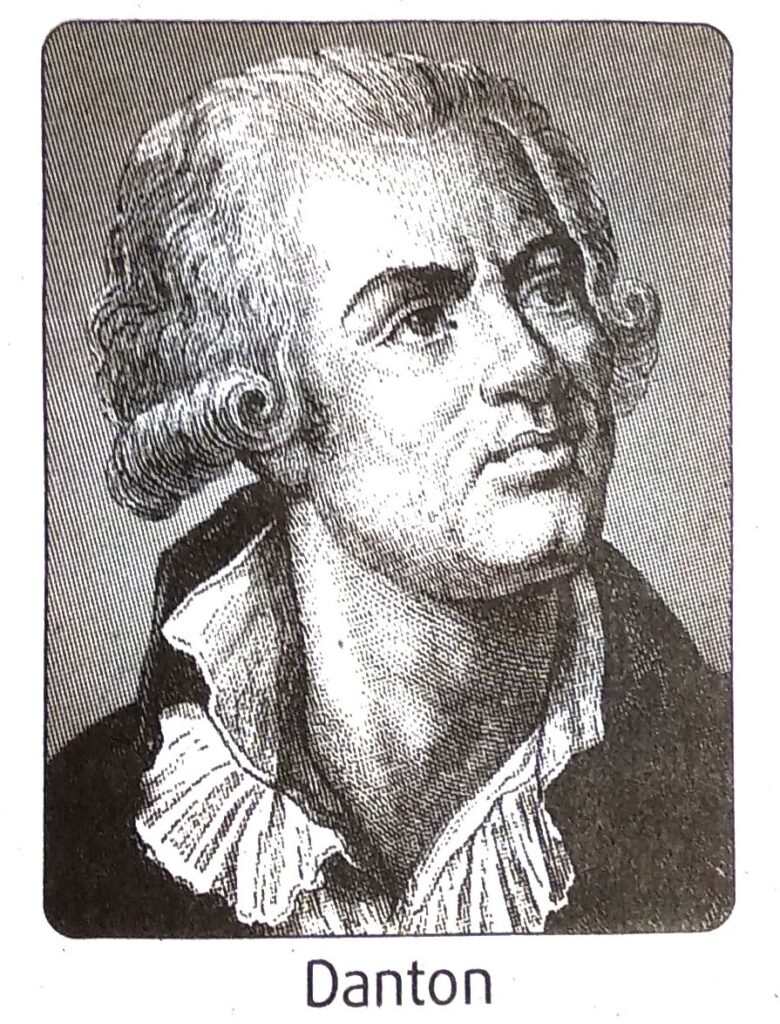
Reign of Terror. Another distinguished leader of the early nineties was Robespierre. He played the most important part in bringing Louis XVI-to trial, declaring that the king ‘must die so that the country may live’.
10. What do you mean by ‘The Revolutionary Tribunal’ introduced during the Reign of Terror?
Ans. One of the instruments of the Reign of Terror was the Revolutionary Tribunal. The judges of this Tribunal were appointed by the Committee of Public Safety. The function of the Revolutionary Tribunal was to punish persons held under the Law of Suspects. Nobody could appeal against the decision of this court. Justice was almost always denied as the judges were directed to give their decisions hastily without going deep into the case. Thousands of men and women were guillotined according to the judgements of the Revolutionary Tribunal during the Reign of Terror.
11 What was the ‘Law of Suspects’?
Ans. The ‘Law of Suspects’ was one of the instruments through which the Committee of Public Safety executed the Reign of Terror. This law empowered the police to arrest any individual on mere suspicion of antirevolutionary activities. The suspected persons were then sent for trial. Not one of the persons sent for trial by the Revolutionary Tribunal was declared innocent-each and every one of them was sent to the guillotine.
Short Answer (SA) Type Questions
Answer in 2 to 3 sentences
1. What was the significance of the fall of the Bastille ?
Ans. [1] The fall of the Bastille (14 July, 1789) proved that the king had no longer any control over Paris, the capital. [2] The attack and destruction of the Bastille was a moral victory for the people of France over the autocratic monarchy. [3] It was a victory of liberal values over the absolute monarchy. [4] It created an atmosphere of horror and terror among the absolute monarchs of Europe.
2. Differentiate between Active and Passive Citizens of France.
Ans. The Constituent Assembly divided the citizens of France into two categories-active and passive.
Men who were above 25 years of age and who paid taxes equal to at least 3 days of a labourer’s wage were given the status of active citizens and they had the right to vote. The remaining men and women of France who could not fulfil the above criteria and did not have the right to cast their vote were called passive citizens.
3. Which estate of the French society gained from the constitution of 1791? Which estates were dissatisfied and why ?
Ans. Members of third estate of French society gained from the Constitution of 1791.
Members of the First and Second Estate were dissatisfied because their privileges were abolished and instead they had to pay taxes in proportion to their means.
Know More
Important leaders who took part in the drafting of the constitution of 1791.
◆ Mounier
◆ Mirabeau
◆ Lafayette
◆ Barneve
◆ Talleyrand
4. What do you mean by ‘Cahiers’?
Ans. All the delegates who came from different parts of France to attend the session of the States-General in the grand hall of the Royal Palace of Versailles on 5 May 1789 brought with them complaints, memorandums and demands of their respective areas. These were known as ‘Cahiers’.
5. What were the different political parties in the National Convention?
Ans. The four different political parties in the National Convention were; [1] the Constitutionalists, [2] the Girondins, [3] the Jacobins and [4] the Moderates.
6 Which incident is known as the ‘Second French Revolution’?
Ans. On the morning of 10 August, 1792, the members of the Jacobin Club stormed the Palace of Tuileries, massacred the king’s guards and held the king hostage for several hours. Later, they voted to imprison the king’s family. Dethronement of the king virtually made France a ‘Republic’. Historians have called this incident of 10 August, 1792 the ‘Second French Revolution’.
7 Who were the members of the Jacobin Club ?
Ans. The members of the Jacobin Club were from poor classes. They included small shopkeepers, artisans like shoemakers, watchmakers, pastry cooks and daily wage earners.
8. Why were the Jacobins so named?
Ans. The members of the old Breton Club used to hold their meetings in the church named ‘Jacob’. That is why the members of this club came to be known as the Jacobins.
9. Who were the Girondins?
Ans. The Girondins, one of the four political parties in the National Convention, played a prominent role in the French Revolution. The significant leaders of the party were Brissot, Condorcet, Petion and Madam Roland and their chief aim was to establish a republican form of government in France. Though they were staunch revolutionaries, they did not support violence, lawlessness and anarchy.
10. Describe the incident of the storming of the Palace of Tuileries.
Ans. On the morning of 10 August, 1792, the members of the Jacobin Club stormed the Palace of Tuileries, massacred the king’s guards and held the king hostage for several hours. Later, they voted to imprison the king’s family.
11. Why was the Reign of Terror introduced?
Ans. On 21 January, 1793 when King Louis XVI of France was executed, there were outbursts of rebellion from the king’s supporters. Besides, monarchical countries such as Britain, Holland, Prussia and Austria formed a coalition and declared war against the republican of France. The government National Convention tried to protect the country from internal threats and external aggression by setting up an emergency government and following a strategy of terror where all opposition was ruthlessly suppressed. This period from June 2, 1793 July 27, 1794 is called the Reign of Terror.
12 What were the three instruments through which the Reign of Terror was made effective?
Ans. The three instruments through which the Reign of Terror was made effective were: [1] the Committee of Public Safety, [2] the revolutionary Tribunal and [3] the Law of Suspects.
13 What was the Committee of Public at was Safety ?
Ans. The Committee of Public Safety was one of the instruments of the Reign of Terror. The Committee was given the responsibility of appointing important ministers and high ranking officers of the armed forces. Two further committees-the Committee of General Security and the Revolutionary Tribunal were formed within this committee for its better functioning.
14 What is Thermidorian Reaction’?
Ans. The reaction which took place in France after the death of Robespierre, the leader of the Reign of Terror, is known as Thermidorian Reaction’. By this time the terrorists were put to death and the Reign of Terror and Paris Commune were dissolved. All the subordinate machinery of the Reign of Terror was abolished. The prisoners whose guilt was in doubt were released and the National Guards was reorganised. All this stemmed from the reaction of the middle class.
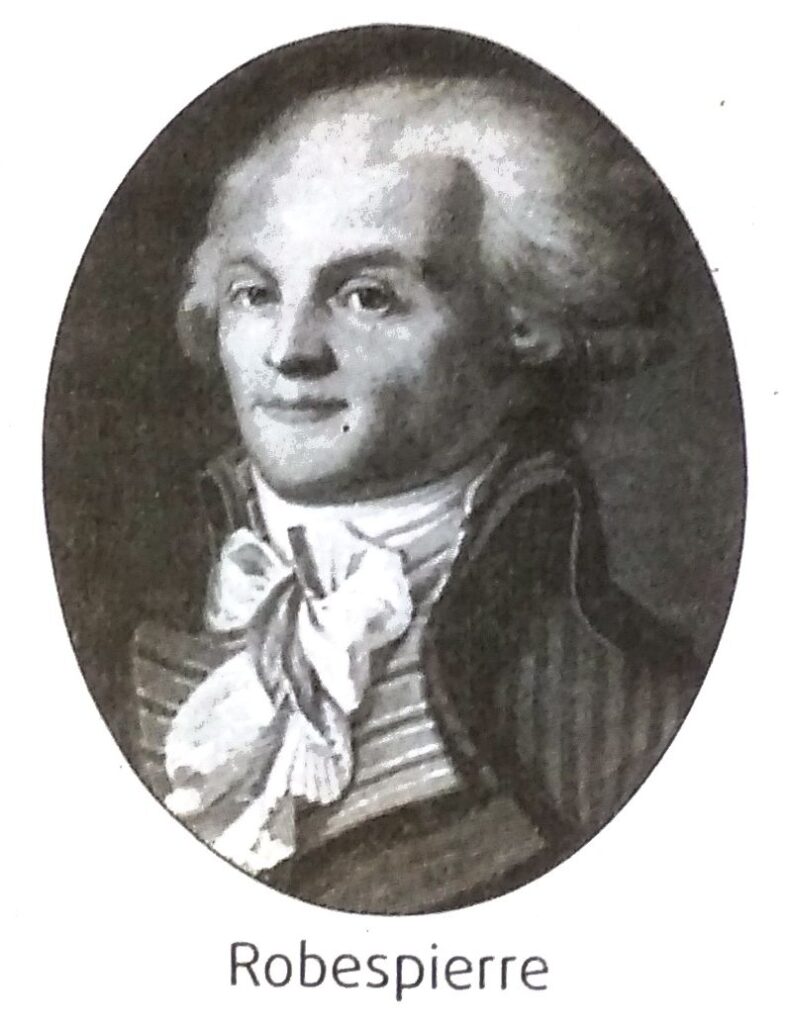
15 What was Tipu Sultan’s relation with the Jacobin club?
Ans. The Jacobin club, the largest and most powerful political club of the French Revolution, had an Indian ruler, Tipu Sultan, the ruler of Mysore, among its associates. He was the founder-member of the Jacobin club in India. He actively supported the proposal of the French soldiers at Seringapatam to set up a Jacobin club in 1797 and when it was established, he ordered a salute of 2300 cannons and 500 rockets to celebrate the occasion.
16 What was the Brunswick Manifesto ?
Ans. King Louis XVI tried to restore monarchy France with foreign help. When the Parisian mob attacked the Tuileries Palace and humiliated the king, the king tried to flee to Austria along with his wife. In August 1792, the Duke of Brunswick, the general appointed by the Austro-Prussian government, issued a manifesto and warned France that any injury or insult to any member of the royal family would be severely dealt with. This is known as the Brunswick Manifesto.
17 What was Directory? Why was dismissed ?
Ans. After the fall of the Jacobins, a new Constitution was formed which denied the right to vote to citizens without property. It provided two Legislative Councils which appointed a Directory with five members.
However, the Directors often clashed with the Legistative Councils and were finally dismissed. Political instability resulted which led to the rise of a military dictator, Napoleon Bonaparte.
18. What laws were made to improve the status of women in French society ?
Ans. The revolutionary government in France introduced some laws to improve the lives of women in France. [1] Schooling was made compulsory for all girls. [2] Women could be trained for jobs, could run small business or become artists. [3] Fathers could no longer force their daughters to marry against their will. [4] Divorce was made legal and could be applied for by both men and women.
19 Who was the king and queen of France when the French Revolution broke out ?
Ans. When the French Revolution broke out the king of France was Louis XVI and the queen was Marie Antoinette.
20 What is guillotine ?
Ans. Guillotine is a device for beheading a person, widely used during the French revolution. It was invented by Dr. Joseph Ignace Guillotin. With the help of this machine many people were beheaded during the Reign of Terror.
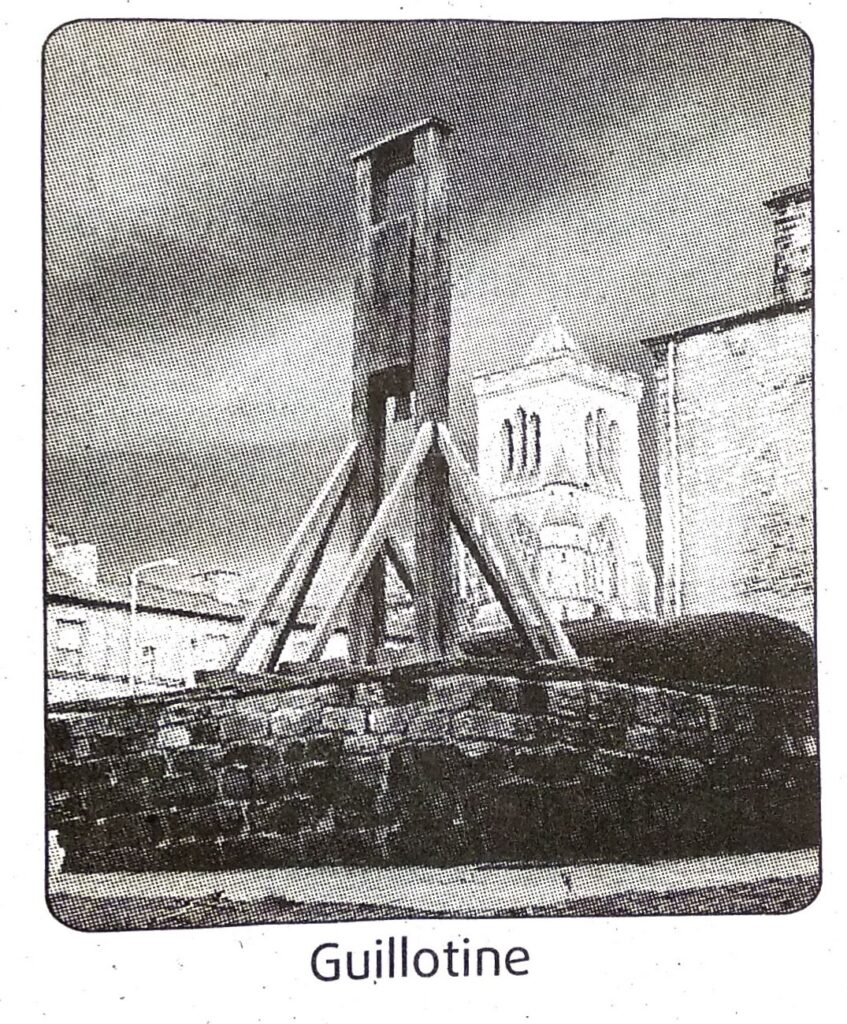
Know More
SOME PERSONS WHO WERE GUILLOTINED:
King Louis XVI,
Queen Marie Antoinette,
Louis Philippe,
Madam Elizabeth,
Robespierre,
Danton,
Marat,
Madam Roland,
Bailey,
Brissaud,
Barnave,
Vergniaud.
21 How were the passive citizens deprived of their voting rights?
Ans. The Constituent Assembly divided the citizens into two categories Active and Passive. The Active citizens who held property above a certain prescribed limit got the right to elect their representative but the passive citizens were deprived of their voting rights.
22 Mention two liberal measures undertaken during the Reign of Terror.
Ans. Two liberal measures undertaken during the Reign of Terror were: [1] Tax rate was enhanced for the moneyed class but reduced in case of middle class [2] Minimum wages of labourers were fixed in order that they might not be exploited.
23 How did feudalism come to an end in France?
Ans. Due to rural unrest, on August 4, 1789 the nobility and the clergy voluntarily renounced the privileges enjoyed by them for a long time. With this feudalism came to an end in France. The National Constituent Assembly announced “the National Assembly abolishes the feudal system entirely”.
24 How did the Constitution of 1791 collapse ?
Ans. The Jacobins successfully organised a revolt against the king and queen of France who took shelter in the nearby Assembly for fear of their life. The Jacobins forced the Assembly to suspend the monarchy. The king was imprisoned and the constitution of 1791 collapsed.
25 Mention the importance of the Reign of Terror.
Ans. [1] The Reign of Terror was necessary in order to suppress rebellion of the royalists. [2] During the Reign of Terror the French government was successful in conducting the foreign affairs.
Very Short Answer (VSA) Type Questions
Answer in one sentence
1. What was Bastille?
Ans. Bastille was the fortress-prison in the city of Paris, the capital of France.
2. When was the Bastille attacked?
Or, What was the date of the fall of Bastille?
Ans. The Bastille was attacked on 14 July, 1789.
3. Why was the Bastille hated by the people of France?
Ans. The Bastille was hated by the people of France because it stood for the despotic power of the monarch and also symbolised oppression of the people by the autocratic French kings.
4. What was ‘Paris Commune’?
Ans. After the fall of the Bastille, Paris went out of royal control. Paris Commune consisting of elected representatives began to conduct the administration of the city of Paris.
5. What were the ‘assignats’?
Ans. The Constituent Assembly confiscated all properties of the church and keeping those as security, issued a kind of paper note called ‘assignats’.
6. Who was the founder of Patriotic Party?
Ans. The founder of Patriotic Party was Abbe Sieyes.
7. What do you mean by the Civil List introduced by the Constituent Assembly?
Ans. The Civil List was introduced by the Constituent Assembly to determine the royal expenditure which could not exceed the amount allotted in the list.
8. Name two leaders of the Jacobin Party.
Ans. Two leaders of the Jacobin Party were Robespierre and Danton.
9. What was the law enforced by the Revolutionary Tribunal?
Ans. The law enforced by the Revolutionary Tribunal was the ‘Law of Suspects’.
10. Name the countries which formed the first coalition against France.
Ans. The countries which formed the first coalition against France were Austria, Prussia, Britain and Holland.
11. Which countries made the Declaration of Pilnitz and when?
Ans. Austria and Russia made the Declaration of Pilnitz in 1791.
12. What was the new system of administration introduced by the National Convention?
Ans. The new system of administration introduced by the National Convention was the Directory.
13. When did Napoleon become the First Consul?
Ans. Napoleon became the First Consul in 1799.
14. After which incident Louis XVI agreed to call the meeting of States -General?
Ans. After the aristocratic revolt in 1788 Louis XVI agreed to call the meeting of the StatesGeneral.
15. Which day is celebrated as the National Day in France at present?
Ans. 14 July is celebrated as the National Day in France at present.
16. Name two political parties of France during the French Revoution.
Ans. Two political parties in France during the French Revolution were the Girondist and the Jacobin.
17. What was the ‘Great Fear’?
Ans. The ‘Great Fear’ was actually the rumour that criminals, brigands, etc. were being sent against the peasantry to avenge the defeat of the nobility in the States-General.
18. What was the period of the Reign of Terror in France?
Ans. The period of the Reign of Terror in France was from 2 June, 1793 to 27 July, 1794.
19. Name two leaders of the Reign of Terror in France. peres
Ans. Two leaders during the Reign of Terror in France was Danton and Robespierre.
20 . Who was Robespierre?
Ans. Robespierre was a leader of the Reign of Terror in France.
21. To which political party did Robespierre belong?
Ans. Robespierre belonged to the Jacobin party in France.
22. In which year was king Louis XVI guillotined?
Ans. King Louis XVI was guillotined on January 21, 1793.
23. Which incident marked the end of the Reign of Terror in France?
Ans. The death of Robespierre, the leader of the Reign of Terror, marked the end of the Reign of Terror in France.
24. Which ruler of India was a member of the Jacobin Club?
Ans. Tipu Sultan, the ruler of Mysore, was a member of the Jacobin Club.
25. What was the Revolutionary Tribunal?
Ans. The Revolutionary Tribunal was set up in France which was responsible for the trial of traitors and counter revolutionaries.
26. What was the Committee of Public Safety?
Ans. During the Reign of Terror in France the Commitee of Public Safety was set up which had the highest power to adopt any measure in the interest of the nation.
27. Who was the leader of the ‘Red Terror’ in France?
Ans. The leader of the ‘Red Terror in France was Robespierre.
28. What was the ‘Law of Suspect’?
Ans. During the Reign of Terror in France the ‘Law of Suspect’ was applied very widely and all persons suspected of antirevolutionary ideas or acts were hauled up before the Revolutionary Tribunal which could sentence anyone to death on mere suspicion.
29. Who was Olympe de Gouges?
Ans. Olympe de Gouges was one of the most politically active women of the revolutionary period in France.
30. Who was the Duke of Brunswick?
Ans. The Duke of Brunswick was the general appointed by Austro-Prussian government.
Mark True or False
1. The Third Estate of the States-General demanded the introduction of vote per order.
2. The Tennis Court Oath was taken by the representatives of the First Estate.
3. In 1789 the French Constituent Assembly, issued a declaration which abolished feudalism in France.
4. The Constituent Assembly granted the right to vote to men of property.
5. Those Frenchmen who paid income tax or property tax equal to three days’ income were marked as passive citizens.
6. Louis XVI entered into a secret negotiation with the king of Prussia.
7. The Bill of Rights of England (1689) was taken as a model to prepare the Declaration of the Rights of Man and Citizen.
8. The members of the Jacobin Club belonged mainly to the prosperous section of society.
9. The only party which initiated the Reign of Terror was the Jacobin Party.
10. One of the positive outcome of the Reign of Terror was the abolition of slavery.
11. Under the Directory French effort was directed against America.
12. The French Revolution developed the idea of dictatorship in France.
Answers :
1. False , 2. False, 3. True, 4. True, 5. False, 6. True, 7. True, 8. False, 9. False, 10. True, 11. False, 12. False.
Fill in the blanks
1. The Tennis Court Oath was taken in (1788/1789/1790).
2. One of the leaders associated with the task of drafting the constitution of 1791 was_________(LouisXVI/
3. Tipu Sultan was the founder member of the Jacobin club that showed allegiance to the____________
(French/English/Portuguese).
4. The _________ (Law of Suspects/Law of Tribunal/ Law of Maximum) was enforced to check the soaring prices of goods.
5. The September Massacre continued from 2 September to 6 September,__________(1792/ 1793/1794).
6. The incident of the execution of ___________(Louis XVI/Marie Antoinette/Robespierre) and his associates which brought an end to the Reign of Terror came to be known as the Thermidorian Reaction.
7. France was under Directory rule from____________ (1795-1799/1798-1799/1799-
8. The Directory had _________ (three/four/five) Directors.
9. Among the Directors of France,_______ (Carnot/Pache/Dumoureiz) was the most famous.
10. The French government was divided into _________ (80/82/83) departments to streamline the administration.
11. By a military coup ____________ Robespierre/Napoleon) (Louis XVI/ seized the administrative power of France in 1799.
Answers :
1. 1789
2. Talleyrand
3. French
4. Law of Maximum
5. 1792
6. Robespierre
7. 1795-1799
8. five
9. Carnot
10. 83
11. Napoleon
Choose the best explanation
1. Statement: People of France destroyed the Bastille fort.
Explanation (A) : The fort was old dilapidated.
Explanation (B) : The fort was a symbol of tyranny.
Explanation (C) : It was a fort of enemy state.
2. Statement: Representatives of the third estate took the Tennis Court Oath.
Explanation (A) : They wanted to maintain a good relationship with the aristocracy.
Explanation (B) : They wanted to prepare a new constitution for the country.
Explanation (C) : They demanded to transfer the power to Sans-culottes.
3. Statement : France lost her status as an international power in the 18th century.
Explanation (A) : There was immense loss of men and money.
Explanation (B) : France was defeated in the War of Austrian Succession and the Seven Years’ War.
Explanation (C) : There was reign of terror in France.
4. Statement: King Louis XVI called an assembly of the States-General in 1789.
Explanation (A) : Louis XVI needed a solution of the prevailing economic crisis.
Explanation (B) : Louis XVI was forced to called the assembly under pressure of third estate.
Explanation (C) : Louis XVI called the assembly to formulate trade policy.
Answers :
1. Explanation (A)
2. Explanation (B)
3. Explanation (C)
4. Explanation (A)
Multiple Choice Questions (MCQ)
1. The Constitution of 1791 vested the power of making laws in the
A. Lok Sabha
B. Provincial Assembly
C. General Assembly
D. National Assembly
Ans. D
2. The New Assembly elected in 1792 by general franchise came to be known as the
A. Constituent Assembly
B. Legislative Assembly
C. Local Council
D. National Convention
Ans. D
3. One very important reform introduced by the Jacobin regime was the abolition of
A. monarchy
B. Slavery in French colonies
C. dictatorship
D. Feudalism
Ans. B
4. Marie Antoinette, the queen of Louis XVI, was guillotined in-
A. 1793
B. 1795
C.1796
D.1801
Ans. A
5. Louis XVI was sentenced to death by a court on the charge of
A. murder
B. treason
C. plundering
D. wasting money
Ans. B
6. European coalition was formed against France by
A. Holland, Prussia, Austria, Britain
B. Holland, Prussia, Russia, Britain
C. Holland, Prussia, Austria, America
D. Holland, Prussia, Austria, Italy
Ans. A
7. The ideas of democratic rights and liberty were the most important legacy of the
A. Glorious Revolution
B. Russian Revolution
C. French Revolution
D. Industrial Revolution
Ans. C
8. One of the directors of the Directory was
A. Abbe Sieyes
B. Necker
C. Napoleon
D. Marat
Ans. A
9. The First Consul bestowed with administrative powers was
A. Mirabeau
B. Calonne
C. Napoleon
D. Quesnay
Ans. C
10. Louis XVI called the States-General which met for the last time in
A.1613
B. 1614
C. 1789
D. 1792
Ans. B
11. The States-General met on May 5, 1789 after a long lapse of
A. 74 years
B.174 years
C. 172 years
D. 154 years
Ans. C
12. The Finance Minister of Louis XVI’s government was
A. Danton
B. Robespierre Necker
C. Marat
D. Necker
Ans. D
13. Revolt against the king of France was first started by
A. Nobility
B. Aristocrats
C. Clergy
D. Sans – Culottes
Ans. B
14. Assignats were
A. promissory notes
B. tax on salt
C. indirect tax
D. guild
Ans. A
15. The currency which was in use in France Was
A. Assignat
B. Livre
C. note
D. tithe
Ans. A
16. In 1795 the members of National Convention prepared a new constitution known as the
A. Council
B. Directory
C. Consulate
D. States-General
Ans. B
17 The year of September Massacre was
A.1791
B. 1793
C. 1789
D.1792
Ans. D
18. A violent mob attacked the Bastille on
A .July 15, 1789
B.July 14, 1789
C. May 1, 1788
D.June 1, 1789
Ans. B
19 The Constituent Assembly divided the into how many departments ?
A. 83
B. 84
C. 38
D. 86
Ans. A
20. Louis XVI was executed because
A.he was against the revolution
B.he was an autocrat
C. he was a revolutionary
D. he joined in a conspiracy against the foreign powers
Ans. D
21. After whose execution Reign of Terror ended in France ?
A. Danton
B. Louis XVI
C. Robespierre
D. Marat
Ans. C
TOPIC . D
Miscellaneous
Explanatory Answer (EA) Type Questions
Answer in 12 to 15 sentences
1. What were the main causes of the French Revolution ?
Ans. The French Revolution broke out in 1789. The main causes which sparked off the French Revolution were as follows:
[1] Despotic rule of Louis XVI: King Louis XVI, had drained the financial resources of France in successive wars. To meet the cost of his extravagant lifestyle, he increased taxes which were paid by the Third Estate.
[2] Rising prices: Due to rise of population in France there was more demand of food. grains. So the price of food soared and the poor could not afford to buy food. So the gap between the rich and the poor widened.
[3] Division of of French society: French society was divided into three estates-the first estate, the second estate and the third estate. The first and the second estates enjoyed privileges yet did not pay taxes. The Third Estate paid heavy taxes both direct and indirect. This discrimination led to the outbreak of revolution by the third estate.
[4] Role of French philosophers: French philosophers like Rousseau, Voltaire and Montesquieu propagated the ideas of a society where people would enjoy freedom, equality before law and equal opportunities. Their ideas inspired the common people to rise in rebellion.
[5] Presence of educated people: Unlike other countries, France had an enlightened middle class and other professionals like lawyers, administrative officials who were educated and believed that no group in society should be privileged by birth. It was they who organised the people and inspired them to revolt.
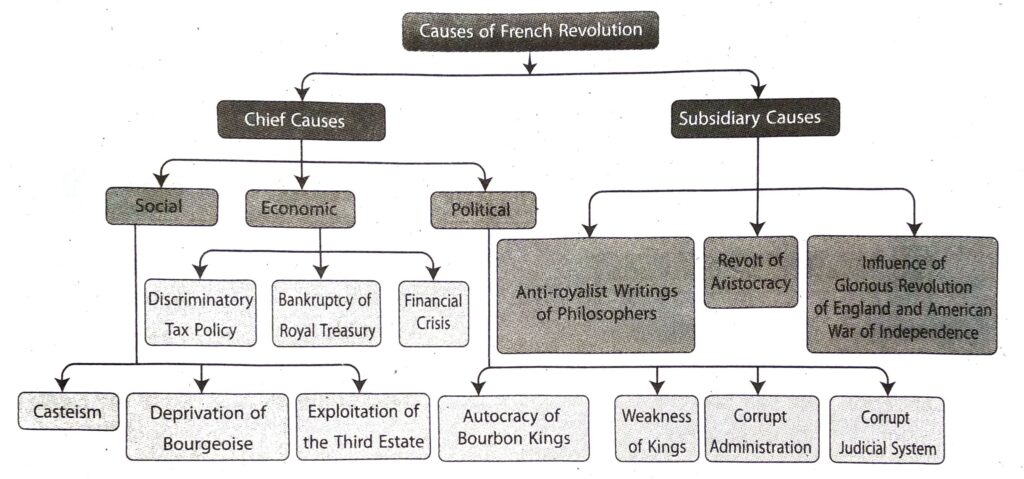
2. Why did the French Revolution break out in France only and not in any other country ?
Ans. Different historians have put forward different theories as to why Revolution broke out in France and not in any other country. However, it is possible to find out some common factors which made the Revolution in France inevitable.
[1] The miserable economic condition of the people of France. and the poor management of finances by the government of France contributed to the outbreak of the Revolution in France. The tottering economic structure of France was a very important cause for the outbreak of the Revolution.
[2] The burden of tax on the common people was much higher than anywhere else in Europe. So the intensity of discontent was much more among the peasants in France than in other parts of Europe.
[3] The feudal system in France became worn out. In different European countries feudal lords enjoyed privileges and performed their duties but in France the feudal lords enjoyed rights and privileges without. rendering any services to the king. The French people resented this system of unequal privileges and wanted to do away with this inequality in the society.
[4] The backward agricultural and industrial condition of France. resulted in under production which led to excessive rise in food prices. This made the people of France burst out in rebellion.
[5] The presence of the French philosophers who resented the privileges of the nobles and the absolutism of French monarchy contributed to the outbreak of the Revolution only in France.
[6] Unlike in other countries, France had an enlightened middle class. It was they who organized the people and taught them to revolt.
3. What is the importance of the French Revolution?
Ans. The French Revolution is one of the greatest landmarks in the history of the world.
Importance: [1] The French Revolution changed the course of history of France. It destroyed the old order and replaced it with a new system. [2] The revolution put an end to the absolutism of the French kings. [3] The revolutionary and republican ideas took strong roots in France. [4] After the revolution the ideals of liberty, equality and fraternity became popular and these ideals remained as a source of inspiration for revolutions which took place in the 19th century Europe. [5] The revolution established people’s participation in political administration and equality in the eye of law.
Follow on Facebook page – Click Here
Google News join in – Click Here
Read More Asia News – Click Here
Read More Sports News – Click Here
Read More Crypto News – Click Here